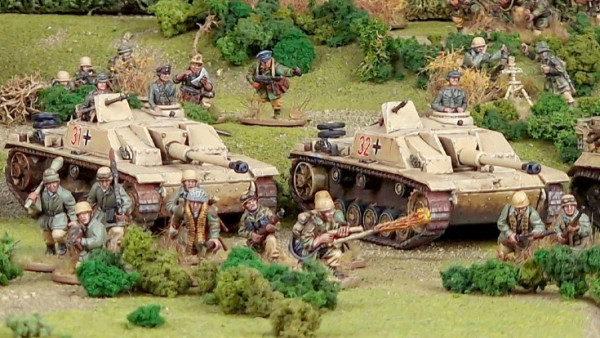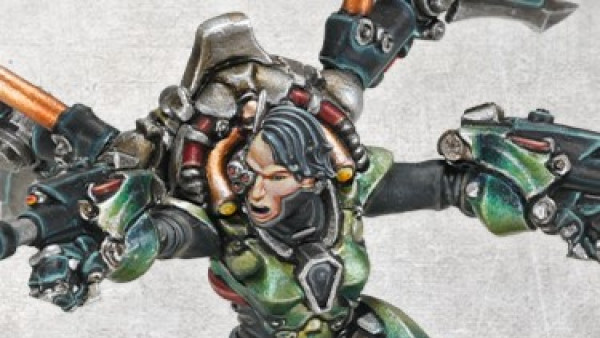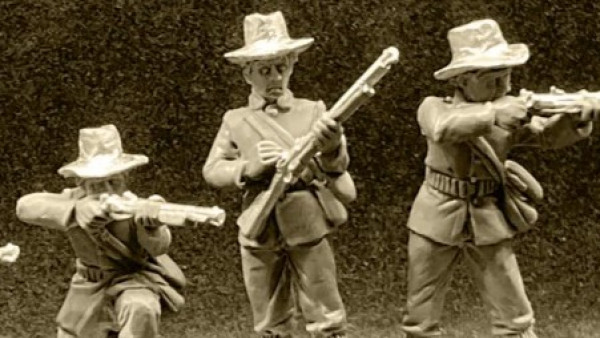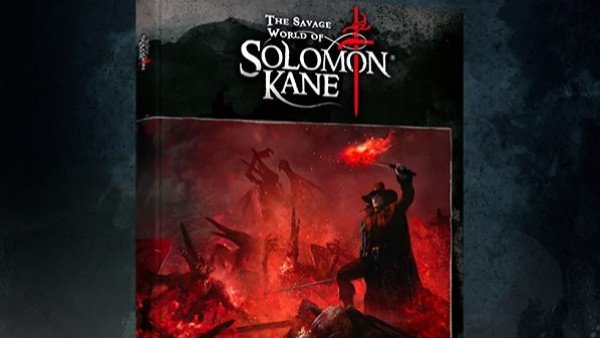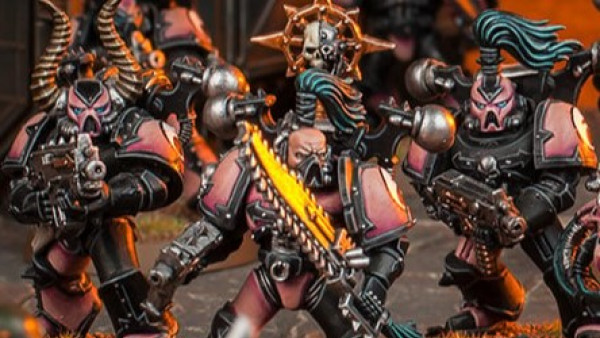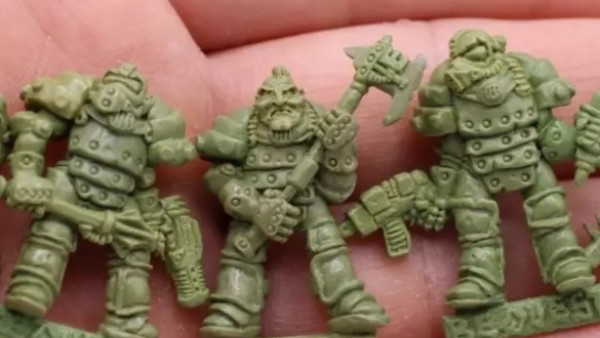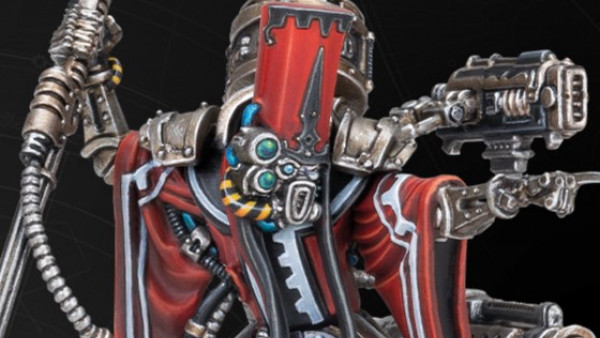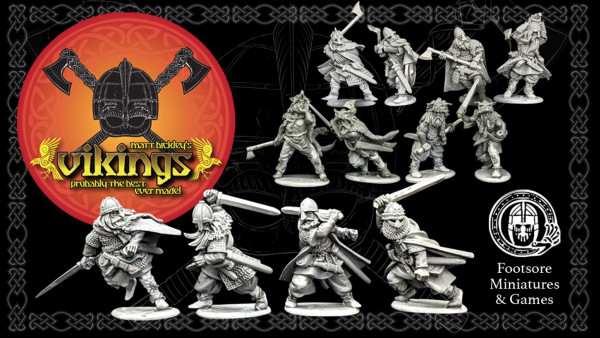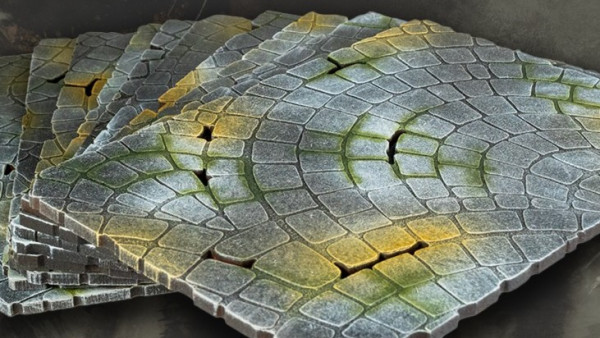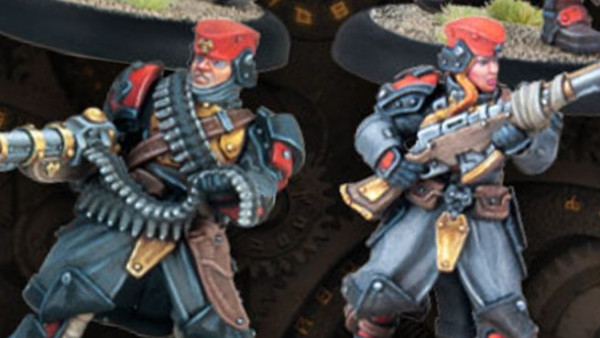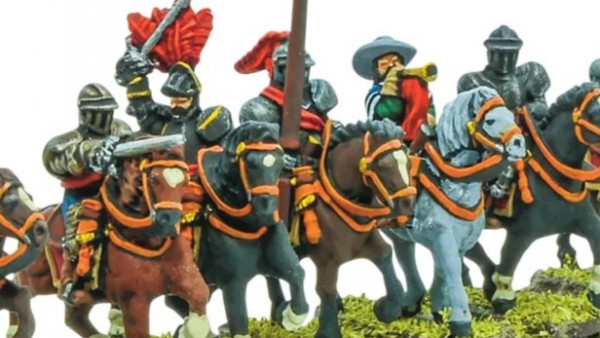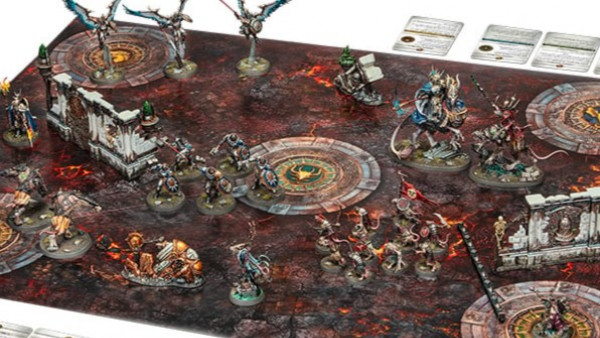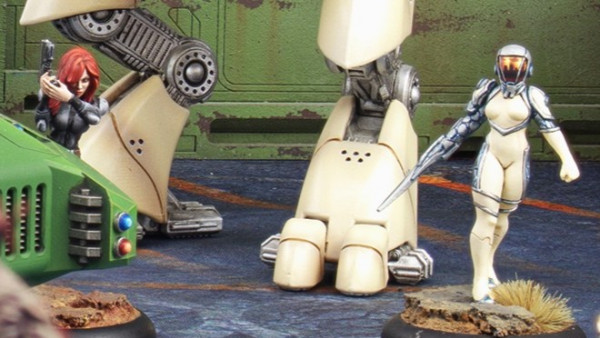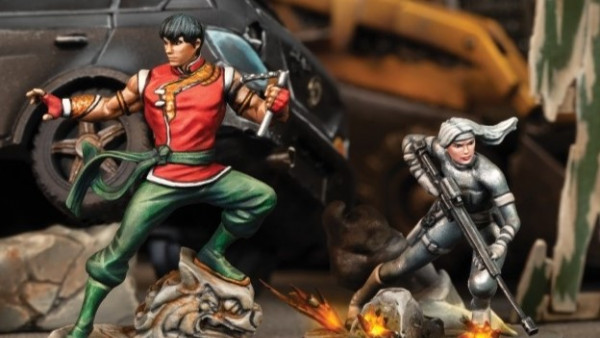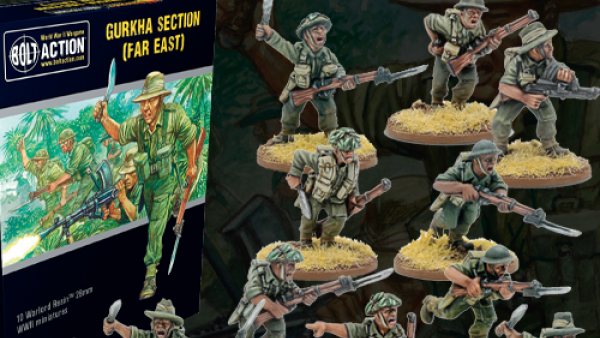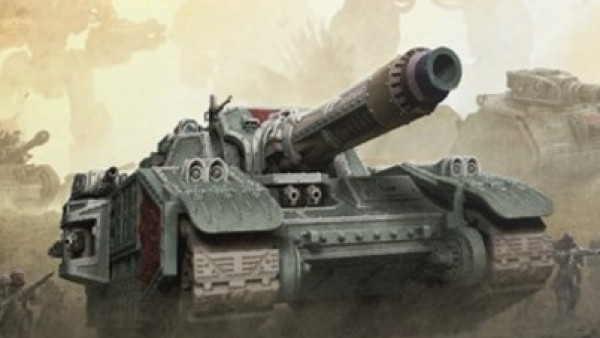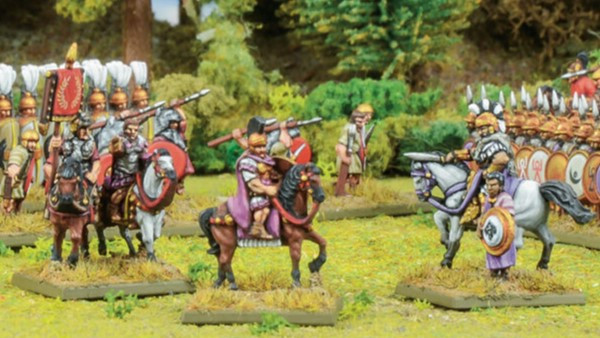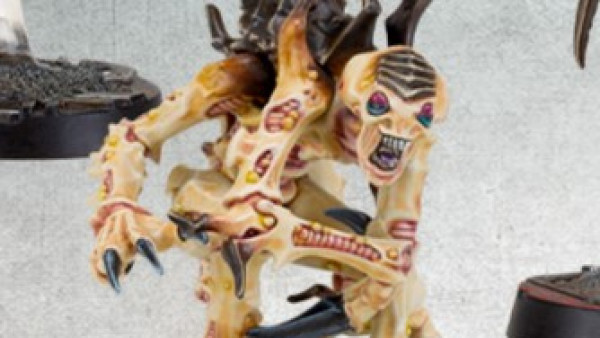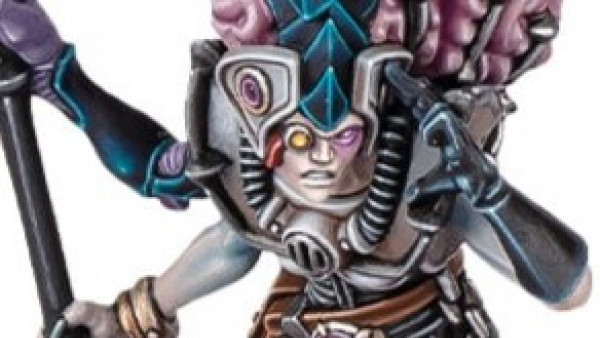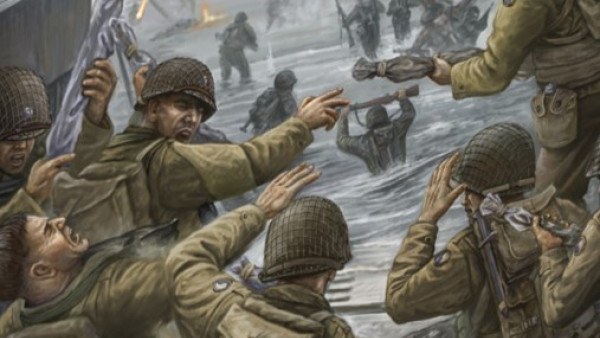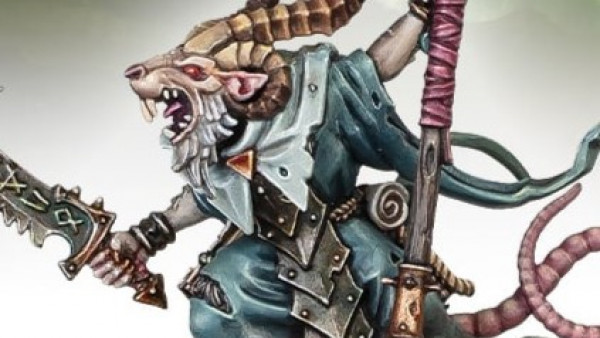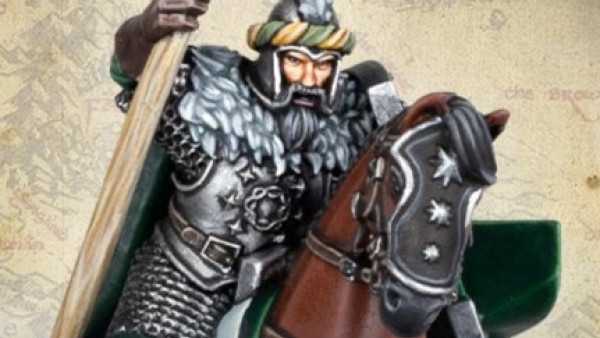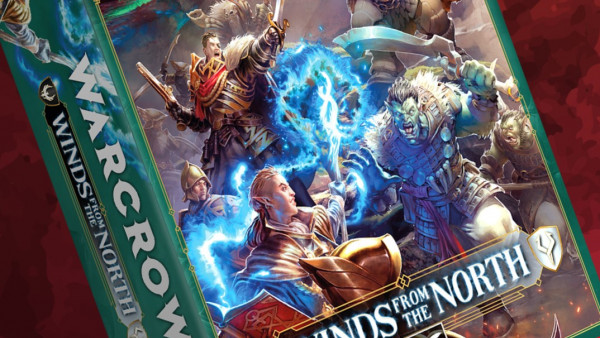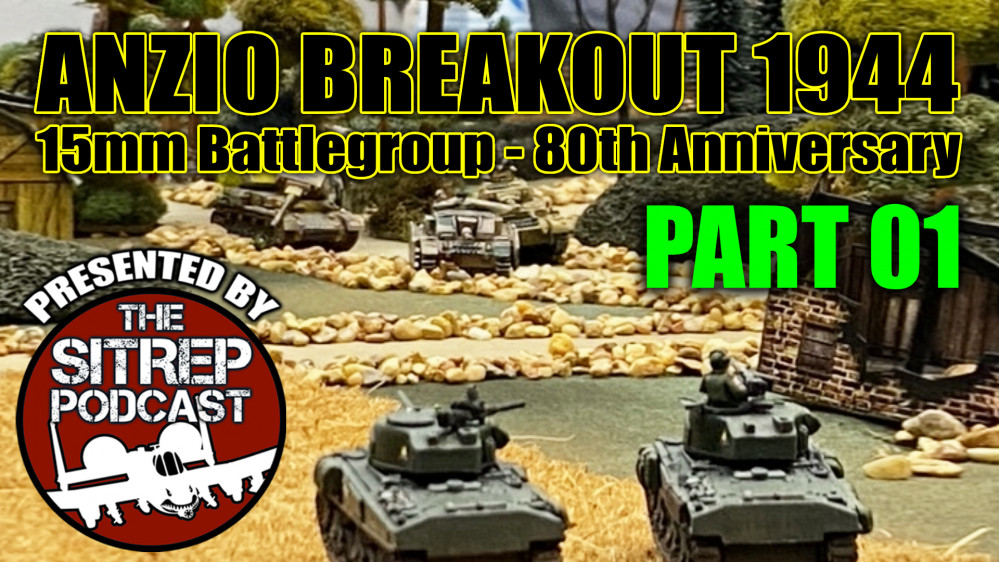
Breakout at Anzio – 80th Anniversary
Recommendations: 12527
About the Project
Lately, I've been running war games every weekend with members of the community via web conference. Players log on and play wargames with each other in real time, regardless of location, and we usually have at least a couple spectators as well. Many times it’s been Darkstar, but we’re also running wargames in Panzer Leader, Arab-Israeli Wars, and now Valor & Victory.
BoW/OTT community members @brucelea, @damon, @davehawes, and @rasmus have taken the plunge, leading battalions across thousands of meters of desert, starfleets in pitched battles across the heavens, or vicious firefights in the jungles of Vietnam, all without leaving the comfort of their home.
Hard-core, old-school command-tactical wargames can now be run (complete with spectators and recordings) in real time, with BOTH PLAYERS moving pieces across THE SAME virtual game board, thus maintaining player agency, speedy and instant results (no play by e-mail), interwoven turn sequences, any questions / feedback instantly received and addressed, and with the game being virtually recorded as it goes, a ready-made battle report can actually be created as we go.
All of this without the players having to install any new software on their computer, on any platform (PC or Mac). All that's needed is to agree on a time, a handful of dice, and a bellyful of courage!
Every weekend can now be a boot camp! All without costing me thousands of dollars in airfare, too!
Related Game: PanzerBlitz
Related Genre: Historical
This Project is Active
Change of Gears - Heading Back to 'Nam for Some Special Forces Action
So I’ve taken a brief break from Omaha to build and run a game with @stvitusdancern on the Sitrep Command Team. The game was Valor & Victory (Barry Doyle, Vietnam Expansion by @oriskany) where we pitted a platoon of US Special Forces up against Vietnamese regulars (PAVN) near the Laotian border, Kon Tum Province, South Vietnamese Central Highlands, III Corps, mid-December 1967.
The general situation in this part of the war was dominated by a VC/NVA build-up for the Tet Offensive that would hit in January-February 1968. During this build-up, large contingents of NVA troops and weapons for the VC would come down the the Ho Chi Minh Trail through Laos and Cambodia – with branches leading off the trail at many points, leading into South Vietnam. American and ARVN ground forces were not allowed into Laos and Cambodia, but they could interdict these forces as they crossed into South Vietnam, hopefully stopping the buildup and perhaps using intelligence gained in these actions (prisoners / captured documents) to build a better picture about the Tet Offensive that was building up.
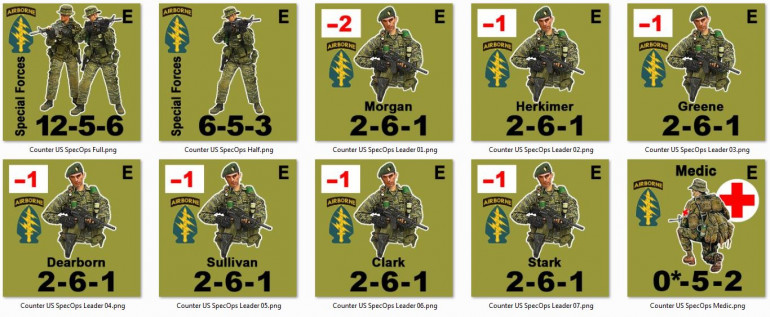 So here are the Special Forces units I put together in Valor & Victory to facilitate this game. We have Special Forces squads, half-squads, and medic teams. There are also leaders. They are named for American Revolutionary War Generals. The leader is Morgan, named for Daniel Morgan, leader of the 11th Virginia (the "Virginia Riflemen") and founder of the Rangers. He is often recognized as the "father" of American Special Forces.
So here are the Special Forces units I put together in Valor & Victory to facilitate this game. We have Special Forces squads, half-squads, and medic teams. There are also leaders. They are named for American Revolutionary War Generals. The leader is Morgan, named for Daniel Morgan, leader of the 11th Virginia (the "Virginia Riflemen") and founder of the Rangers. He is often recognized as the "father" of American Special Forces. 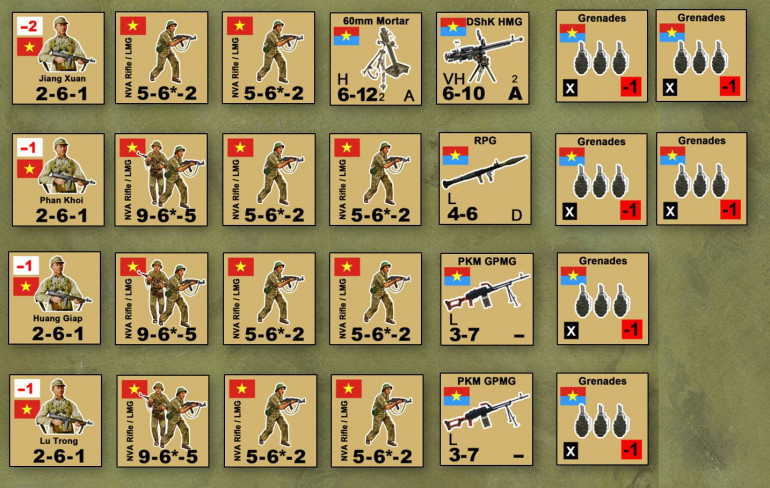 Vietnamese forces. These the People's Army of Vietnam (PAVN), often called in Western Press as the NVA (North Vietnamese Army). These are not South Vietnamese communist guerrillas like we see with the VC (National Liberation Front, or NLF). This is a hardened, trained, regular rifle company of the formal army of Hanoi.
Vietnamese forces. These the People's Army of Vietnam (PAVN), often called in Western Press as the NVA (North Vietnamese Army). These are not South Vietnamese communist guerrillas like we see with the VC (National Liberation Front, or NLF). This is a hardened, trained, regular rifle company of the formal army of Hanoi.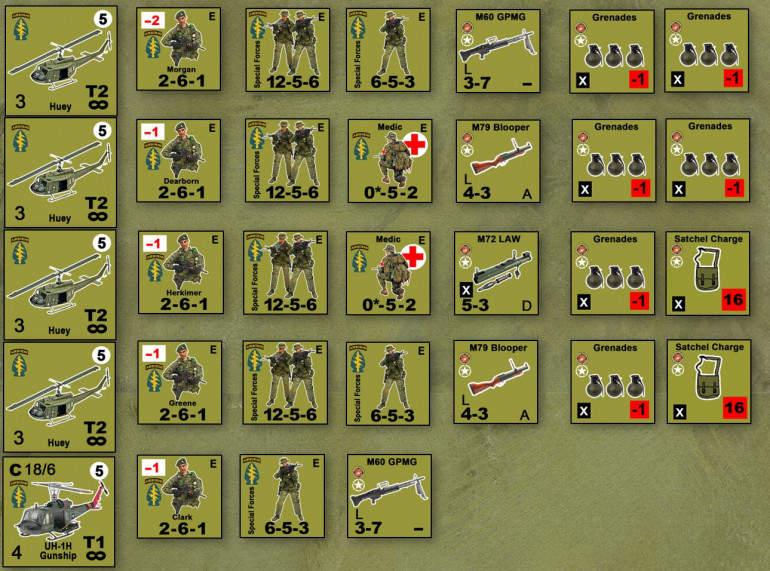 The Special Forces platoon. They are carried in four UH-1 Iroquois transport helos (more typically called the "Huey") - the "slick" configuration without significant guns. The last helo on the bottom is a full-on UH-1H Gunship, which has sacrificed half its troop carrying capacity for some small degree of armor plating and rockets and guns ... LOTS of guns.
The Special Forces platoon. They are carried in four UH-1 Iroquois transport helos (more typically called the "Huey") - the "slick" configuration without significant guns. The last helo on the bottom is a full-on UH-1H Gunship, which has sacrificed half its troop carrying capacity for some small degree of armor plating and rockets and guns ... LOTS of guns.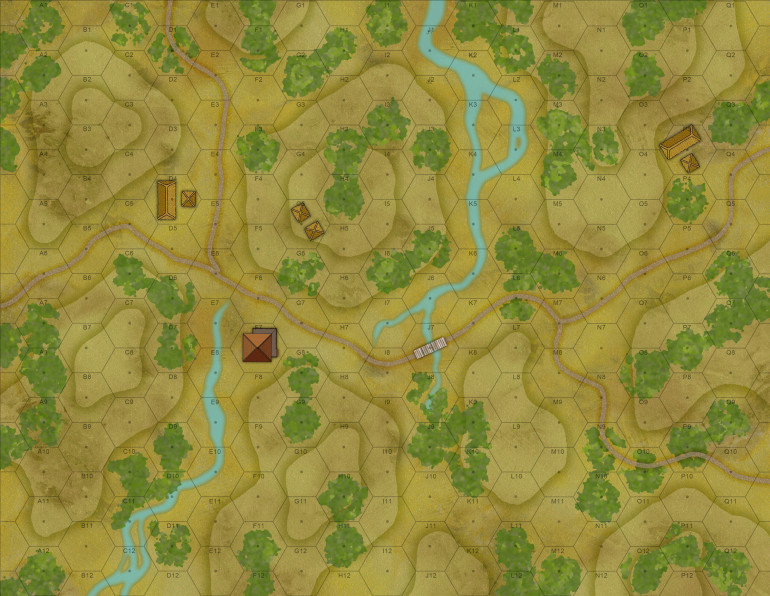 Here is the map I drew up for this game, live on Twitch, on Thursday. Seven objective hexes will be designated. Gianna must take at least four (the majority) to win the game by the end of Turn 6.
Here is the map I drew up for this game, live on Twitch, on Thursday. Seven objective hexes will be designated. Gianna must take at least four (the majority) to win the game by the end of Turn 6. The battle begins. All NVA units begin "masked" - obscured as black counters until Gianna's troops spot them, move adjacent to them, or they fire on Gianna's units. During her initial movement phase (as helos entered the board), my NVA captain and a heavy machine gun crew on high ground (DShK 12.7mm) open fire on one of her birds, hitting and damaging it but JUST MISSING shooting it down. Instead it is "Pinned" (helos that are "pinned" have to withdraw from range of enemy gunfire and stay there until "rallied".) But now that NVA gun position is revealed, and in comes Gianna's gunship to release .50 cal, 7.62mm MG, and 2.75-inch rockets. BOOM! There goes the DShK (and my captain). However, the American commander (Captain Morgan) has landed on the ground to the east and headed north into those hooches, only to discover that those masked NVA units were "dummies" - "EMPTY JUNGLE." Throughout the game Gianna will have to discern where my forces really are, and how they are deployed. The Vietnamese are always hidden in this war, after all.
The battle begins. All NVA units begin "masked" - obscured as black counters until Gianna's troops spot them, move adjacent to them, or they fire on Gianna's units. During her initial movement phase (as helos entered the board), my NVA captain and a heavy machine gun crew on high ground (DShK 12.7mm) open fire on one of her birds, hitting and damaging it but JUST MISSING shooting it down. Instead it is "Pinned" (helos that are "pinned" have to withdraw from range of enemy gunfire and stay there until "rallied".) But now that NVA gun position is revealed, and in comes Gianna's gunship to release .50 cal, 7.62mm MG, and 2.75-inch rockets. BOOM! There goes the DShK (and my captain). However, the American commander (Captain Morgan) has landed on the ground to the east and headed north into those hooches, only to discover that those masked NVA units were "dummies" - "EMPTY JUNGLE." Throughout the game Gianna will have to discern where my forces really are, and how they are deployed. The Vietnamese are always hidden in this war, after all. 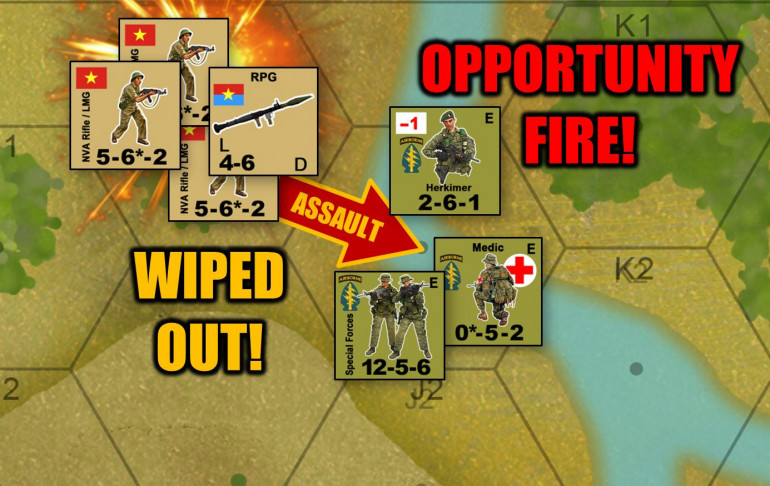 Some more NVA units reveal themselves to the north, where I try to attack MSgt Herkimer's Squad once it becomes a little too isolated wading across that stream. That's three half-squads, one of them carrying an RPG-7. But those are Special Forces, and their opportunity fire more or less annihilates this force before they can mount the assault. So far we have one NVA officer and 16 men either killed, wounded, or driven off, with really no losses to the Americans other than a damaged UH-1 (and perhaps a wounded pilot or co-pilot or crew chief). But this game is just getting started!
Some more NVA units reveal themselves to the north, where I try to attack MSgt Herkimer's Squad once it becomes a little too isolated wading across that stream. That's three half-squads, one of them carrying an RPG-7. But those are Special Forces, and their opportunity fire more or less annihilates this force before they can mount the assault. So far we have one NVA officer and 16 men either killed, wounded, or driven off, with really no losses to the Americans other than a damaged UH-1 (and perhaps a wounded pilot or co-pilot or crew chief). But this game is just getting started! Omaha Map Complete - American Forces Built and Set Up
The Omaha Beach Panzer Leader mega-game continues to come together. The overall map is now complete (2500+ hexes, 24 square miles, or almost 63 square kilometers, estimated 2800 Flames of War tables).
American landings are researched and set up to pretty precise to the historical plan, we’ll see what the current, tides, beach obstacles, and enemy fire do to it.
Now I just have to set up the Germans.
The project is temporarily paused, however, to facilitate construction of a Valor & Victory Vietnam game for Saturday.
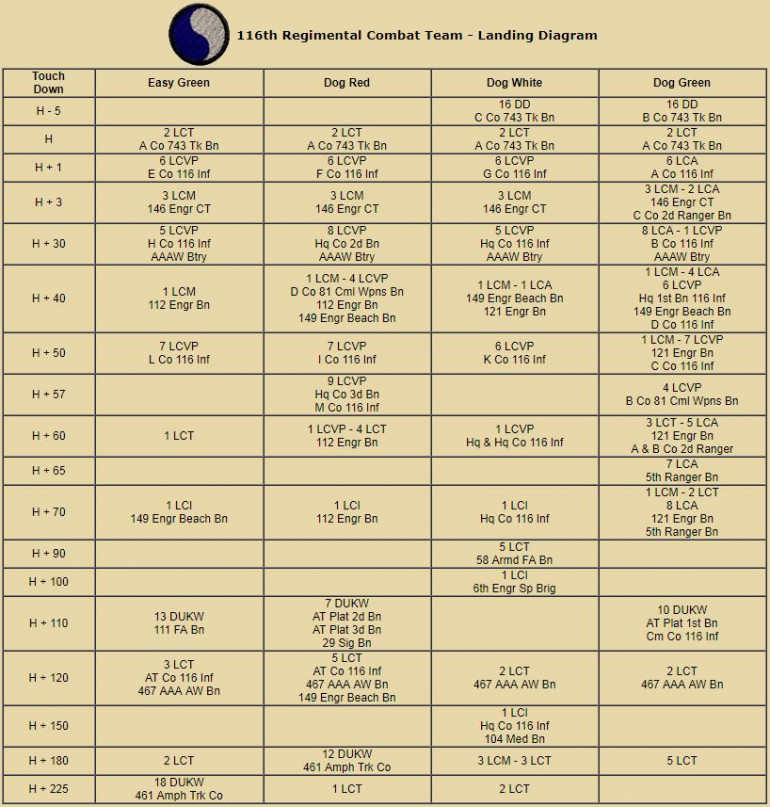 American landing research for 116th Regimental Combat Team (29th US Infantry). not only do we have to account for all these units and when and where they are scheduled to land, but also their size,composition, and equipment.
American landing research for 116th Regimental Combat Team (29th US Infantry). not only do we have to account for all these units and when and where they are scheduled to land, but also their size,composition, and equipment.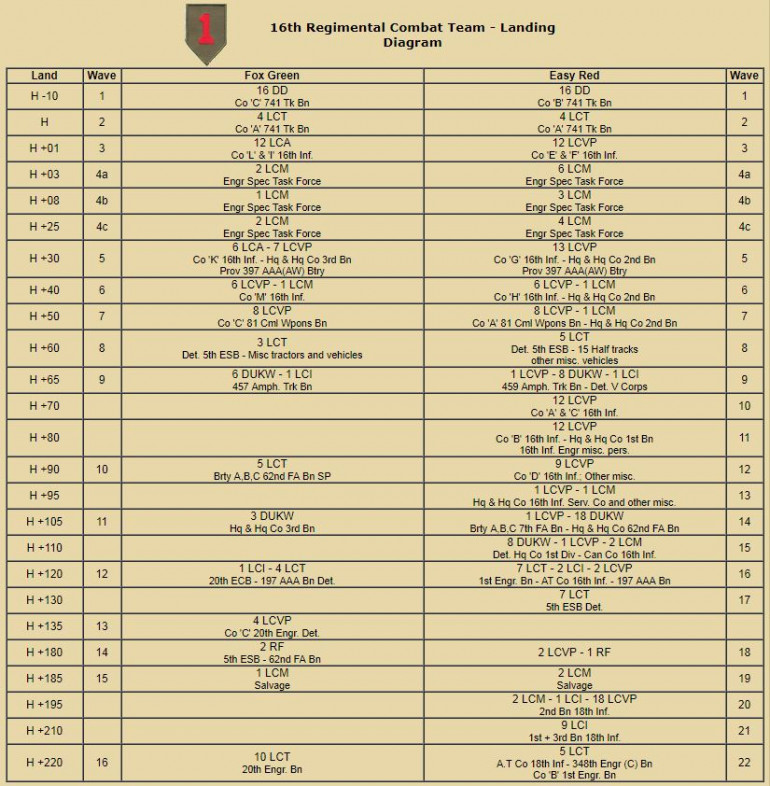 Same with the 16th Regimental Combat Team (US 1st Infantry Division), followed by the 18th RCT that lands behind them mid-morning.
Same with the 16th Regimental Combat Team (US 1st Infantry Division), followed by the 18th RCT that lands behind them mid-morning. 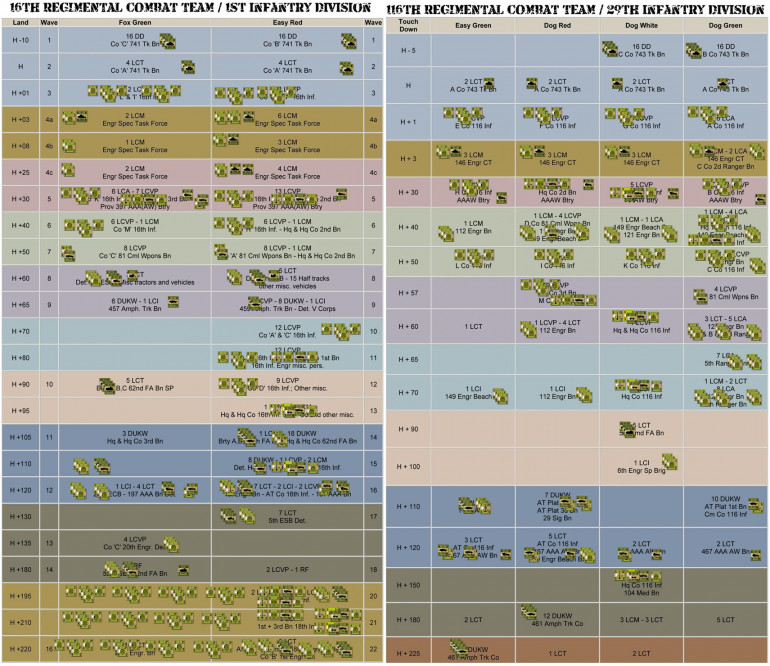 Converted to Panzer Leader and set up on a color-coded phased turn landing schedule. Each color is a different turn of the game (20 turns in all, I think) and has a designated beach assault sector Every piece is a platoon of 5 tanks or 50 men, or a battery of 4-6 guns. Clearly this game is going to be ridiculously gigantic. This doesn't include air support or offshore naval gunfire support. Fortunately, the Germans are far less numerous.
Converted to Panzer Leader and set up on a color-coded phased turn landing schedule. Each color is a different turn of the game (20 turns in all, I think) and has a designated beach assault sector Every piece is a platoon of 5 tanks or 50 men, or a battery of 4-6 guns. Clearly this game is going to be ridiculously gigantic. This doesn't include air support or offshore naval gunfire support. Fortunately, the Germans are far less numerous.Omaha Beach - Panzer Leader - Map and Counter Construction
So after the success of last week’s Gold Beach game (Gold Beach is one of the British invasion beach zones during the D-Day landings of June 6, 1944), I thought I would create a new scenario for Omaha Beach, the big American beach depicted in Saving Private Ryan.
The system will be Avalon Hill’s Panzer Leader.
This will be a monster game, play-tested solitaire (not live … it would literally take days). But the ambition here is to run all of Omaha Beach, in true scale, no shortcuts, no gimmicks.
So far I have the map mostly complete – with the American units built.
 The map in its entirety. Each hex is 150 meters, so the map overall is just short of 6 miles wide (10 km)
The map in its entirety. Each hex is 150 meters, so the map overall is just short of 6 miles wide (10 km)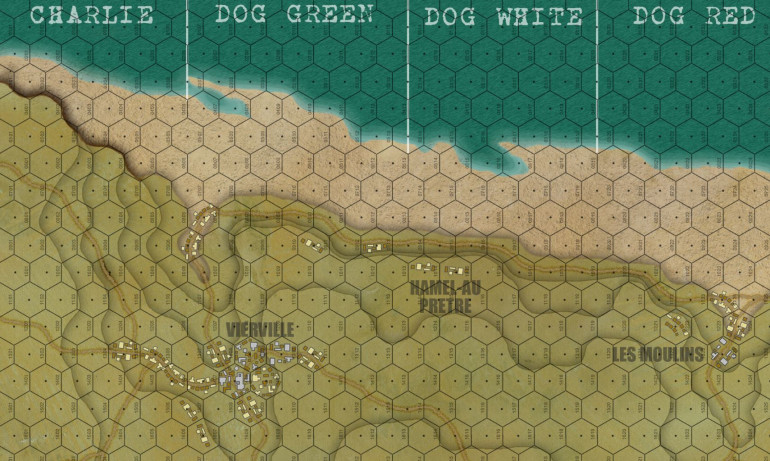 A detail of the Dog Green and the Vierville draw, one the bloodiest sectors of Omaha, by far the bloodiest part of D-Day. This was the setting for Saving Private Ryan, but only a small slice of what we'll be recreating with this game.
A detail of the Dog Green and the Vierville draw, one the bloodiest sectors of Omaha, by far the bloodiest part of D-Day. This was the setting for Saving Private Ryan, but only a small slice of what we'll be recreating with this game.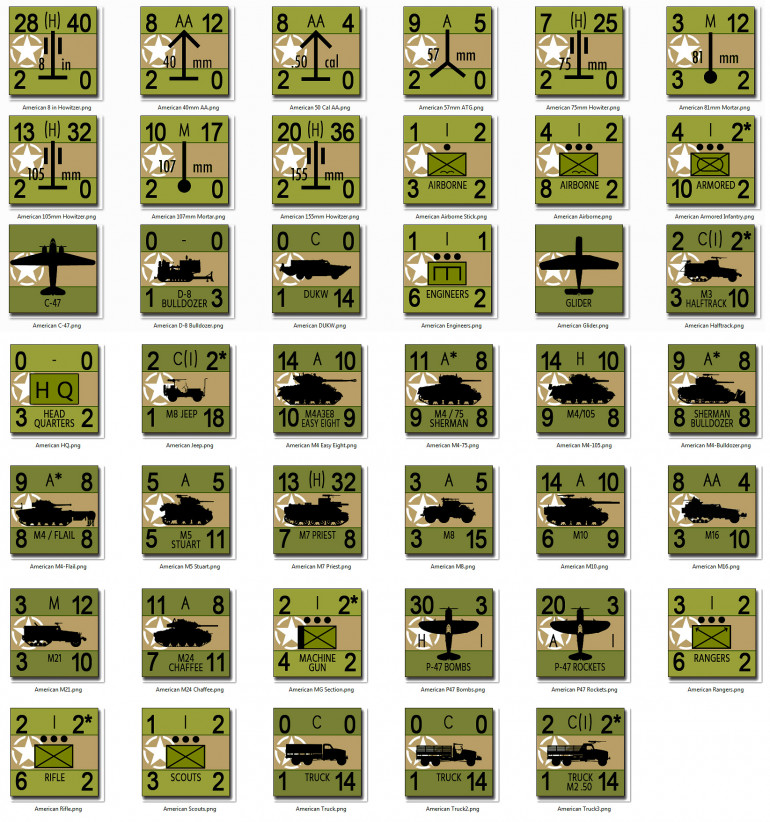 American units for use in the web game. Each piece is a platoon of 5 tanks or about 50 men. We're looking at all the unit TYPES here, there will be hundreds of counters in all on the map. I should say these counters are the start of a complete library for US forces in ETO 1944-45, not all of it will be used on OMAHA BEACH specifically.
American units for use in the web game. Each piece is a platoon of 5 tanks or about 50 men. We're looking at all the unit TYPES here, there will be hundreds of counters in all on the map. I should say these counters are the start of a complete library for US forces in ETO 1944-45, not all of it will be used on OMAHA BEACH specifically.Gold Beach Wargame - Final Video Posted!!
Part III of our Gold Beach Panzer Leader game (myself with the Germans, @brucelea and @damon with the British) has now been posted on the Sitrep YouTube channel. It comes down to the final crunch here, folks, a 9+ hour game to the last turn, and almost the last roll! We have Typhoon fighter bombers, German FlaK, Royal Marine Commandos, Centaur assault tanks, Churchill AVREs, desperate defense and frantic close assaults!
This is one for the record books! With some funny jokes and sound effectsm too! 😀
British units: 1st Hampshire Rifles, 1st Dorsetshire Rifles, 2nd Devonshire Rifles (231st Brigade), “B” Assault Squadron / 6th Royal Engineers, Winchester Dragoons, 47th Royal Marine Commandos, Sherwood Rangers
German units: Infantry Division 352 (Grenadier Rgt 916, III. Battalion) and elements of 441 “East” Battalion, Infantry Rgt 726, 716 Static Infantry Division.
Gold Beach Wargame - Second Video Posted
Part II of our Gold Beach Panzer Leader game (myself with the Germans, @brucelea and @damon with the British) has now been posted on the Sitrep YouTube channel. Now that all the rules, units, history, and initial landings are out of the way, this video jumps straight into the carnage with improved sound, music, and a lot more combat. We see Royal Engineer AVREs blowing up beach obstacles, pipers striding out of landing craft, steadfast defense by German coastal troops, British armored bridgelayers, and Flail tanks clearing lanes through German minefields.
The Germans are just about starting to crack (maybe ???) But have the British lost too much already? And will my reserves be able to seal the breach? 🙂
British units: 1st Hampshire Rifles, 1st Dorsetshire Rifles, 2nd Devonshire Rifles (231st Brigade), “B” Assault Squadron / 6th Royal Engineers, Winchester Dragoons.
German units: Infantry Division 352 (Grenadier Rgt 916, III. Battalion) and elements of 441 “East” Battalion, Infantry Rgt 726, 716 Static Infantry Division.
Gold Beach Wargame - First Video Posted
Things are just getting started here, everyone. Myself, @brucelea , and @damon go over the map setup, the units involved on both sides, some of the objectives and special rules. Finally we get into the opening shore bombardment barrage from HMS Warspite and her escorting destroyers … and then look into the first wave of landings of 1st Hampshire and 1st Dorsetshire.
This one gets bloody fast!
There will be at least two more videos. Again, just the highlights, this game went for nine and a half hours, I wouldn’t even try to record, render, and post that much video. 😐
I hope some of you will check it out! We really try to recreate the historical conditions and tactical situation of 50th Northumberland’s right wing on that fateful day, putting the leading elements (first wave on our table is about 1300 men), 231st Brigade on Jig Green and Jig Red assault beaches.
Gold Beach D-Day Landing Game - COMPLETE (9 Hours!)
Gold Beach Panzer Leader game: COMPLETE
Run Time: NINE HOURS
Result: EPIC
Losses (both sides): BRUTAL
Decision: LAST TURN
Players: (@brucelea and @damon): WARGAME HEROES
D-Day 75th Anniversary: COMMEMORATED
>> End Transmission.
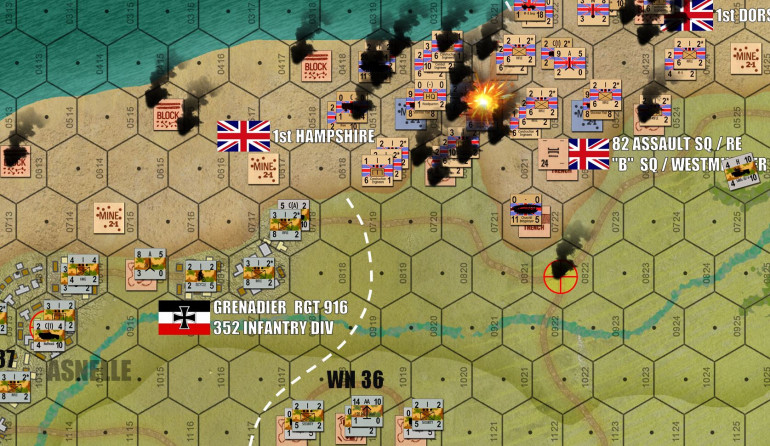 Even amidst this carnage, the Churchill Bridgelayer and other engineers units clear mines, and lay bridges over German antitank ditches. That yellow target icon (hex 0822) is the first objective hex the British will reach.
Even amidst this carnage, the Churchill Bridgelayer and other engineers units clear mines, and lay bridges over German antitank ditches. That yellow target icon (hex 0822) is the first objective hex the British will reach.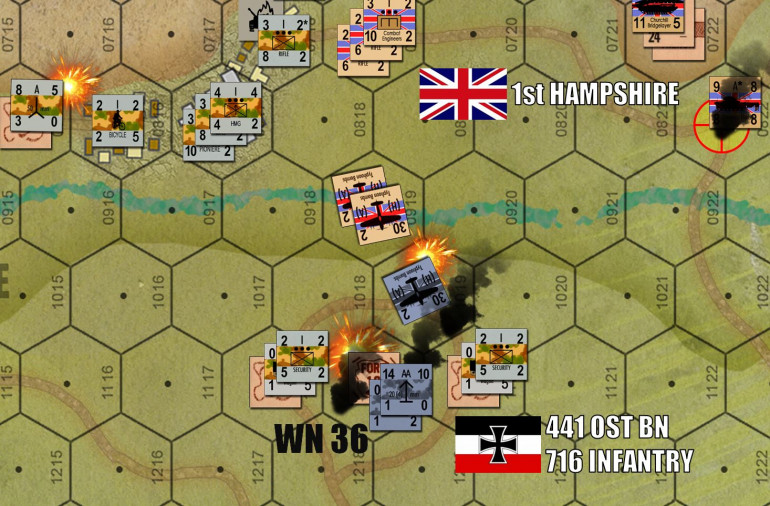 Typhoon airstrikes go in. The first one is shot down, but the two behind it pulverize the HQ of 441st Ost Battalion / 726 IR / 716 ID.
Typhoon airstrikes go in. The first one is shot down, but the two behind it pulverize the HQ of 441st Ost Battalion / 726 IR / 716 ID.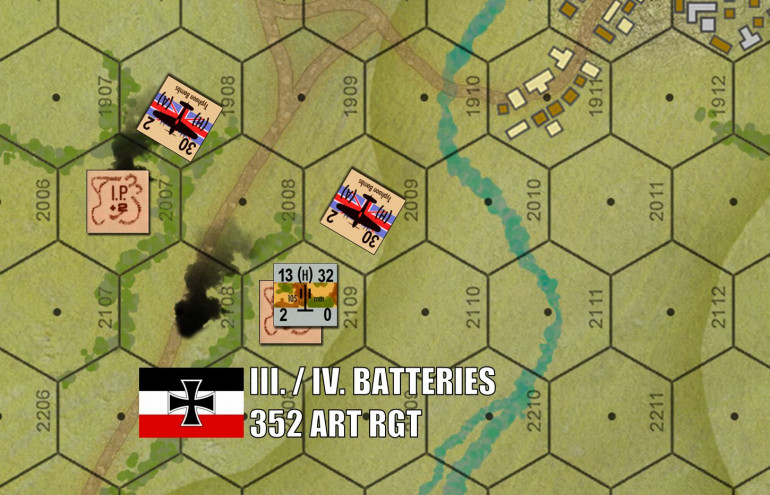 Miles behind the beach, other Typhoons go after 10.5 cm artillery batteries of 352nd Wehrmacht Infantry Division.
Miles behind the beach, other Typhoons go after 10.5 cm artillery batteries of 352nd Wehrmacht Infantry Division.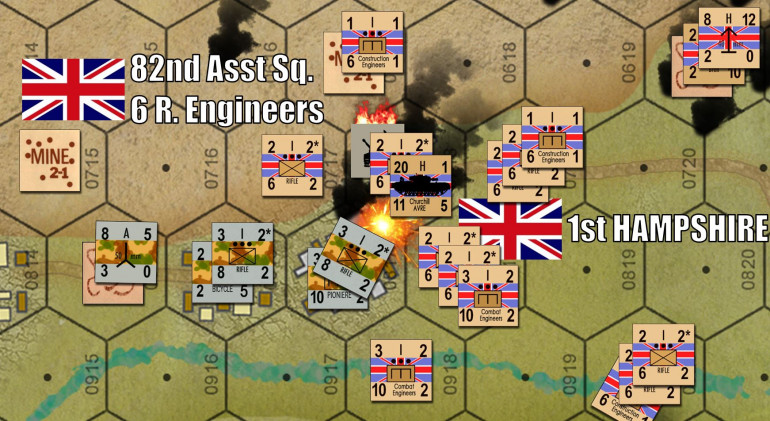 The Churchill AVREs have shoved themselves off the beach and now start launching "flying dustbins" mortar demolition charges into stubborn German defenses (III. Bn / Grenadier Regiment 916 / 352nd Infantry).
The Churchill AVREs have shoved themselves off the beach and now start launching "flying dustbins" mortar demolition charges into stubborn German defenses (III. Bn / Grenadier Regiment 916 / 352nd Infantry).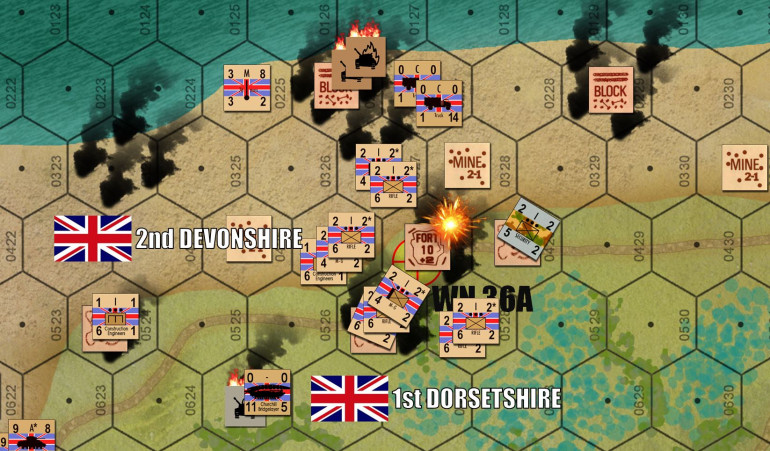 Although the 441 "Ost" Battalion put up a rather pitiful fight historically, here these platoons have stood TALL in the face of Damon's 1st Dorsetshire Rifles and 2nd Devonshire Rifles. It took four turns and two fire missions from battleship HMS Warspite and escorting destroyers to finally dig these badasses out of that "wiederstandnester" bunker complex.
Although the 441 "Ost" Battalion put up a rather pitiful fight historically, here these platoons have stood TALL in the face of Damon's 1st Dorsetshire Rifles and 2nd Devonshire Rifles. It took four turns and two fire missions from battleship HMS Warspite and escorting destroyers to finally dig these badasses out of that "wiederstandnester" bunker complex.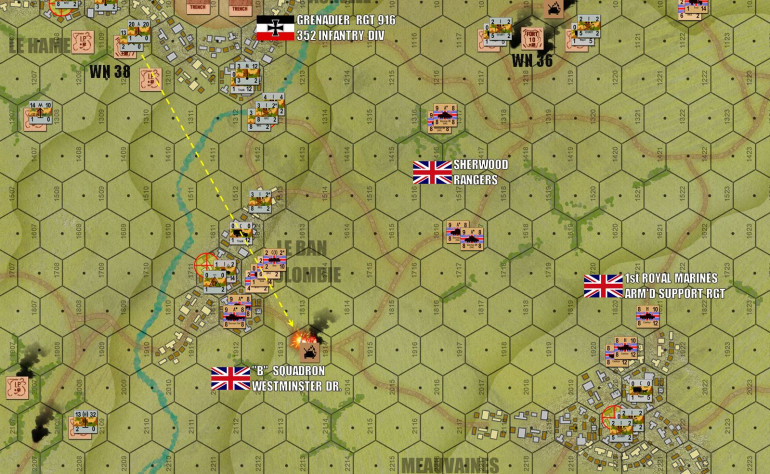 Turn 8: With more armor on the beach, the British now break deep inland, curling southwest (exactly as was done historically) to push for objective hexes in the German backfield.
Turn 8: With more armor on the beach, the British now break deep inland, curling southwest (exactly as was done historically) to push for objective hexes in the German backfield.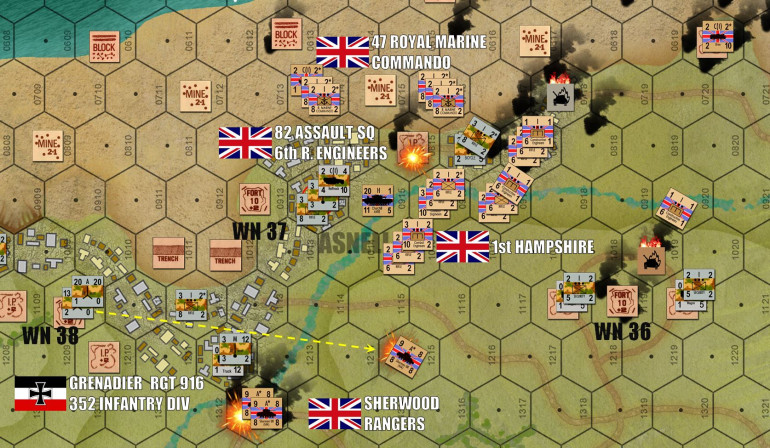 Royal Marine Commandos are now ashore, ready to help British assault engineers and 1st Hampshire with clearing operations of Asnell and Le Hamel. Historically, these were brutal fights that lasted all through the early afternoon of D-Day. Also, we see DD Shermans of Sherwood Rangers push toward the beach exits behind Asnell, one of them pinned down by 8.8 cm fire and a battery of ex-Polish 77mm guns brought over after the 1939 Campaign.
Royal Marine Commandos are now ashore, ready to help British assault engineers and 1st Hampshire with clearing operations of Asnell and Le Hamel. Historically, these were brutal fights that lasted all through the early afternoon of D-Day. Also, we see DD Shermans of Sherwood Rangers push toward the beach exits behind Asnell, one of them pinned down by 8.8 cm fire and a battery of ex-Polish 77mm guns brought over after the 1939 Campaign.Counters Complete - Map Finalized - Special Rules Posted
Okay, we’re all set. Game starts in 1 hour (minus). 😀
SPECIAL RULES:
LANDING:
- Coastal hexes are designated either SEA hexes or BEACH hexes by the color of the hex beneath their central dot.
- At the end of movement, during the turn BEFORE they are scheduled to land (or in the initial set up for first wave units), British units are placed in a SEA hex adjacent to their planned beach landing hex.
- Germans may then fire at them during their subsequent turn.
- RULE SHORTCUT: Unlike “official” Amphibious Landings rules in Panzer Leader, where landing British units are inverted (so Germans cannot see which boats carry which units) – here we will roll a d6. On a 1-2, the German attack hits the intended target. 3-4, the attack hits the “next unit to the left.” On a 5-6, the attack hits the “next unit to the right.”
- As per Panzer Leader XI.D.3, all units except DD tanks are assumed to have an armored DF of 8. DD Shermans get normal DF, Germans must add +2 DRM to DF attacks (obscured target).
- Landing takes place FIRST during the movement phase of the subsequent British turn.
- DD tanks make a d6 roll. On a 1-5, they land normally. On a 6, they sink and are removed.
- All units (including surviving DD tank units) must also make a landing placement roll. Once the British player indicates which hex the unit INTENDED to land, roll a d6.
- 1-2 = unit lands normally.
- 3 = unit lands one hex to the west.
- 4 -5 = unit lands one hex to the east.
- 6 = unit lands two hexes to the east.
- Any unit that hits a block counter while trying to land is destroyed.
- Getting onto the beach hex is that unit’s whole movement.
- Exception: DD Tanks can land and hove half their movement.
- Any units that are CARRIED (towed guns, etc) must debark loaded in their carrier vehicle.
- Non-DD tank units cannot move half once they land (unloaded from LCTs, etc).
- Units scheduled to land on a given turn MUST land on that turn. They cannot “wait” until the beach opens up.
- Any hex that winds up “overstacked” (3 units to a hex) must IMMEDIATELY “lose” a unit per overstacking rules. This takes place BEFORE previously landed units move out of the hex.
- Once all units land on a given turn, units that were already landed in previous turns can now move normally.
- German units taking opportunity fire do not have to make the “shortcut randomizer” roll mentioned above if they shoot at units as they land (using normal unit DFs and target classes).
TERRAIN:
- All Beach hexes cost vehicles double movement.
- Entering a hex where the unit climbs one elevation level costs double movement (infantry included).
- Climbing a bluff hex off a beach hex costs 4 vehicle movement, 2 infantry movement, 6 truck movement. Churchill Bobbin Funnies can lay a carpet in these hexes to make it “clear.”
- Stream: This is a shallow stream. Costs infantry 2 MP to enter. Costs vehicles 4MP to enter, trucks 6MP to enter. Stream does not block LOS. Stream gives +1 DRM. Road negates stream. Churchill Bridgelayers can bridge the stream.
BEACH OBSTACLES:
- Trench rules: Normal. Cannot be crossed at all by any vehicle. No effect on infantry. Can be bridged by Churchill Bridgelayers.
- Mines: Normal. Can be removed by flail tanks per AIW rules. Can be removed by Combat or Construction engineers which move onto the mine hex and roll a 1-2 on 1d6.
- Blocks: No effect on LANDED infantry. Sinks any landing unit that drifts into them. No vehicle can enter a block hex. Can be removed by LANDED engineers who move into the hex and roll a 1-2 on 1d6. Can also be removed by Churchill AVRE that is adjacent to it and declares an attack (BOOM). Removed blocks no longer blow up landing units in subsequent waves.
- Churchill Bridgelayers can lay three bridges. Normal AIR Bridgelaying rules.
- Churchill Bobbins can lay three “roads.” Renders beach hexes and beach bluff hexes normal for movement purposes.
NAVAL GUNFIRE (SHORTCUT RULES):
- British get 50 points of (H) class INDIRECT naval gunfire support on every ODD turn.
- This can be split up into two attacks if desired (20/20, 30/10, 35/5, etc).
- Must be within LOS of the north side of the table (any beach or bluff hex)
- Can also be called in by any non-dispersed, unloaded combat unit (not trucks).
- On a 1-4 it lands as targeted. On a 5-6 the shellfire drifts one hex (1d6).
Counters *Mostly* Complete - Setting up Map
Work continues on the Gold Beach Panzer Leader game scheduled for Saturday, June 8, 4PM UK time.
We created some of the counters and set up some of the map live on Sitrep Twitch Channel last night. We had some great conversation with the role of research in “high-history” games, naval bombardment, the potential role of the panzer divisions, the real reasons why Omaha was so much bloodier than the other beaches, the Juno Beach landings, and different eras of Canadian flags.
After we signed off I tinkered a little with the Germans, and started with a general map set up. I will fill this out and get everything completed later tonight in time for tomorrow’s game.
But for now …
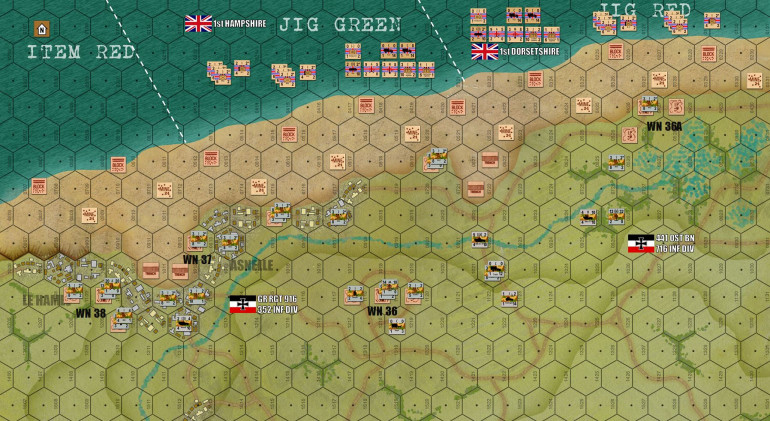 German beach defenses are now in place. WNs = the historical locations and numbers of individual “wiederstandnester” strongpoints, fortification blockhouses represented by “Fortification” counters, flanked by two “IPs” (improved positions – slit trenches, MG nests, mortar pits, sandbags, barbed wire, etc). I also have “Trenches” (antitank ditches) covering the beach egress draws. Minefields are placed in the beach, as well as “Block” counters representing Czech hedgehogs and anti-boat pilings. The British are coming in with A & B Coys, 1st Hampshires and 1st Dorsets, along with their battalion support companies and command groups. Germans are set up with two very distinct troop quality levels, the hard-core 352nd Infantry to the west and the much softer 441 “Ost” Battalion of the 716th Static Division to the east.
German beach defenses are now in place. WNs = the historical locations and numbers of individual “wiederstandnester” strongpoints, fortification blockhouses represented by “Fortification” counters, flanked by two “IPs” (improved positions – slit trenches, MG nests, mortar pits, sandbags, barbed wire, etc). I also have “Trenches” (antitank ditches) covering the beach egress draws. Minefields are placed in the beach, as well as “Block” counters representing Czech hedgehogs and anti-boat pilings. The British are coming in with A & B Coys, 1st Hampshires and 1st Dorsets, along with their battalion support companies and command groups. Germans are set up with two very distinct troop quality levels, the hard-core 352nd Infantry to the west and the much softer 441 “Ost” Battalion of the 716th Static Division to the east.  A close up of German defenses. Their 5.0, 7.5, and even a battery of 8.8s are staged in their approximate historical locations, along with FlaK (2.0 cm, x4 2.0cm), HMG sections, HQ troops, transport (halftracks, trucks, and yes … horse-drawn wagons), mortars, off-board artillery (10.5 cm and 15.0 cm howitzers), etc.
A close up of German defenses. Their 5.0, 7.5, and even a battery of 8.8s are staged in their approximate historical locations, along with FlaK (2.0 cm, x4 2.0cm), HMG sections, HQ troops, transport (halftracks, trucks, and yes … horse-drawn wagons), mortars, off-board artillery (10.5 cm and 15.0 cm howitzers), etc.  Sounds like a tall order. Fortunately, support is close behind. These two squadrons (companies) of the Sherwood Rangers were actually supposed to land at 07:20, five minutes BEFORE the first infantry leapt from the Higgins boats. Didn’t happen, they arrived late, but they will arrive. Of course we have plenty of air support for the British as well. I made sure to include an EVEN number of air strike counters so Damon and Brucelea can split them evenly. No fighting over the Typhoons, please!
Sounds like a tall order. Fortunately, support is close behind. These two squadrons (companies) of the Sherwood Rangers were actually supposed to land at 07:20, five minutes BEFORE the first infantry leapt from the Higgins boats. Didn’t happen, they arrived late, but they will arrive. Of course we have plenty of air support for the British as well. I made sure to include an EVEN number of air strike counters so Damon and Brucelea can split them evenly. No fighting over the Typhoons, please!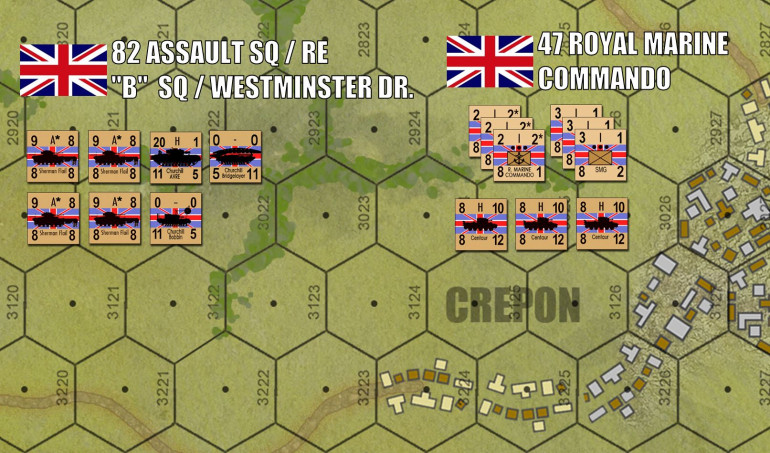 Not gonna lie, I am cheating here SLIGHTLY when it comes to the timing of these units. The mish-mash of 82nd Assault Squadron / 6th Royal Engineers and scattered elements of “B” Squadron, Westminster Dragoons were there at the outset to help the infantry on the beach. I don’t think they had any AVREs, though. The flails, the bobbins were there, though, and will help with getting British vehicles off the beach and clearing German minefields. The Bridges and the AVREs show up later in the afternoon, but like I said, cheating SLIGHTLY and including a sample of these units just to show them off in the game. Same with the 47th Commando. These guys will show up late in the game, but still far sooner than their historical 14:00 hours would indicate.
Not gonna lie, I am cheating here SLIGHTLY when it comes to the timing of these units. The mish-mash of 82nd Assault Squadron / 6th Royal Engineers and scattered elements of “B” Squadron, Westminster Dragoons were there at the outset to help the infantry on the beach. I don’t think they had any AVREs, though. The flails, the bobbins were there, though, and will help with getting British vehicles off the beach and clearing German minefields. The Bridges and the AVREs show up later in the afternoon, but like I said, cheating SLIGHTLY and including a sample of these units just to show them off in the game. Same with the 47th Commando. These guys will show up late in the game, but still far sooner than their historical 14:00 hours would indicate.Looking forward to a great game tomorrow! 😀
British Company Research
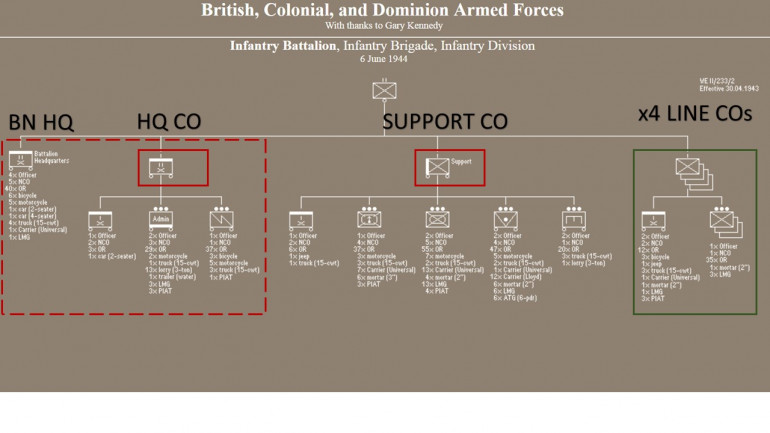 Drilling down a bit, getting the actual compositions of British rifle companies for 1944, and by extension, battalions like 1st Dorsets, 1st Hamps, and 2nd Devons (to be featured in Saturday's game). Next, conversion to Panzer Leader to counters can be created. To be honest, most of these are already created, but they may have to be tweaked since they were last used in the Desert 1942- early 43 games. One example, note that Support Weapons Platoons now contain PIATs - which they did not have in Tunisia. I hope to have some counters up later today. :D
Drilling down a bit, getting the actual compositions of British rifle companies for 1944, and by extension, battalions like 1st Dorsets, 1st Hamps, and 2nd Devons (to be featured in Saturday's game). Next, conversion to Panzer Leader to counters can be created. To be honest, most of these are already created, but they may have to be tweaked since they were last used in the Desert 1942- early 43 games. One example, note that Support Weapons Platoons now contain PIATs - which they did not have in Tunisia. I hope to have some counters up later today. :DBritish Unit Research (detail) and Map Re-draw
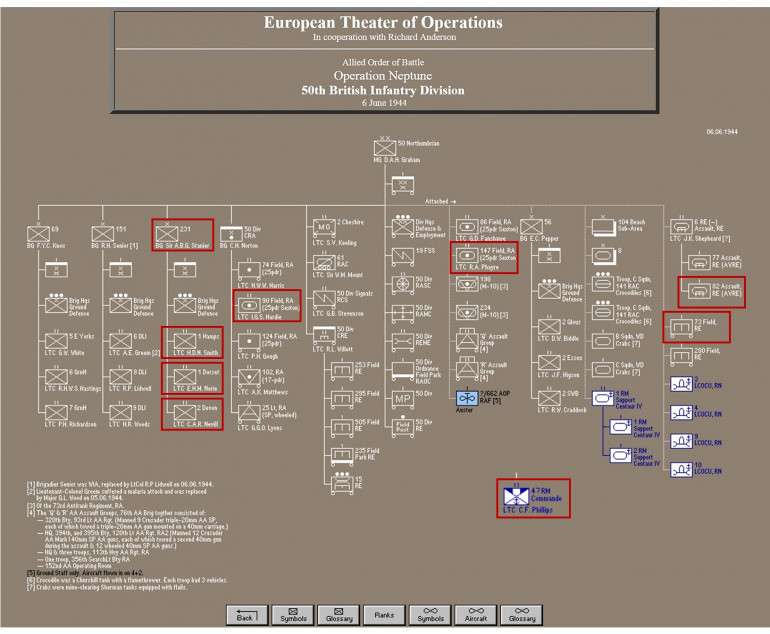 Here are the units I have cross-referenced and verified from at least two sources that WERE THERE at Gold, Jig Sector, first hours of the battle. 1st Hampshires (A & B Coy) lands at Item Green. 1st Dorsetshires (A & B Coy) lands at Item Red. The DD Tanks of Sherwood Rangers that were supposed to land with them were late, but they had a few tanks in the form of specialist armour drawn from 82 Squadron, 6 Assault Regiment / Royal Engineers and "B" Squadron of the Westminster Dragoons. A lot of these are Flails and "bobbins" funnies. Later, 2nd Devonshires lands in a second wave, along with the Sherwood Rangers, a company of the 73rd Field Engineers, two batteries of artillery (Self propelled? Verifiying), and finally the 47th Royal Marine Commando. All this combined makes up the first big wave of 231st Brigade / 50th Northumberland. More details to come.
Here are the units I have cross-referenced and verified from at least two sources that WERE THERE at Gold, Jig Sector, first hours of the battle. 1st Hampshires (A & B Coy) lands at Item Green. 1st Dorsetshires (A & B Coy) lands at Item Red. The DD Tanks of Sherwood Rangers that were supposed to land with them were late, but they had a few tanks in the form of specialist armour drawn from 82 Squadron, 6 Assault Regiment / Royal Engineers and "B" Squadron of the Westminster Dragoons. A lot of these are Flails and "bobbins" funnies. Later, 2nd Devonshires lands in a second wave, along with the Sherwood Rangers, a company of the 73rd Field Engineers, two batteries of artillery (Self propelled? Verifiying), and finally the 47th Royal Marine Commando. All this combined makes up the first big wave of 231st Brigade / 50th Northumberland. More details to come.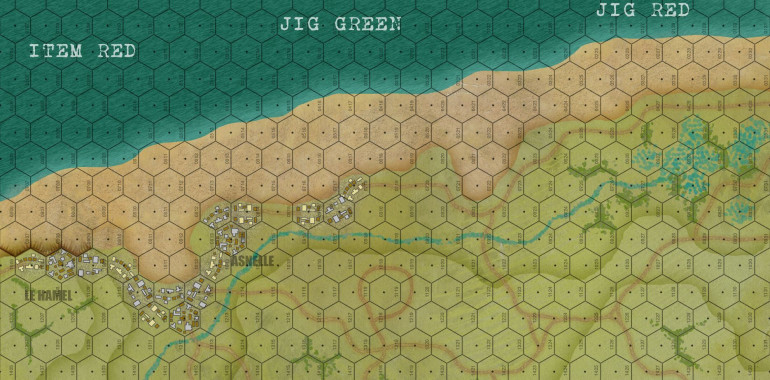 And yes, I know I said I wasn't going to re-draw this map, and in my defense, I didn't ... fully. But I reverted from the "Arab-Israeli Wars" style tree HEXES to the "Panzer Leader" tree HEXSIDES. This will cause less confusion on terrain rules for Saturday's game and besides, I was able to use the HEXSIDE design to better approximate the thin treelines / hedgerows actually on the inland battlefield. I also clarified the cliff hexsides to the extreme west (for those who've been there, these are the cliffs that continue to extend west until you hit those memorials that overlook the Mulberry remains and Museum at Arromanches itself). OPEN IMAGE IN NEW TAB to get a much better resolution.
And yes, I know I said I wasn't going to re-draw this map, and in my defense, I didn't ... fully. But I reverted from the "Arab-Israeli Wars" style tree HEXES to the "Panzer Leader" tree HEXSIDES. This will cause less confusion on terrain rules for Saturday's game and besides, I was able to use the HEXSIDE design to better approximate the thin treelines / hedgerows actually on the inland battlefield. I also clarified the cliff hexsides to the extreme west (for those who've been there, these are the cliffs that continue to extend west until you hit those memorials that overlook the Mulberry remains and Museum at Arromanches itself). OPEN IMAGE IN NEW TAB to get a much better resolution.Map complete - starting counters
Okay, the map is now complete. It’s actually complete whether I like it or not, apparently this afternoon I didn’t save it properly as editable layers … so large scale changes are lo longer possible without re-drawing the whole thing. Apparently the gods are trying to tell me something …
It’s fine! Stop obsessing and get some sleep!
I chose this sector for a number of reasons …
- My two players wanted to try British units (reasonable enough).
- Pretty sure Gold was “tougher” than Sword.
- This part of Gold (“Jig” Sector, turning west inland to fight toward Arromaches in “Item” Sector) is one of the few times we see British seaborne infantry actually fight true German troops that day (as opposed to “Ost” battalions, largely drawn from Belarus and Ukraine).
- We get some Royal Marine Commandos in the second wave (and after all this Falklands work, I loves me some Royal Marine Commandos).
- Two squadrons of tanks also land here (Sherwood Rangers – I think later renamed the Nottinghamshire Rangers?)
- The terrain here is interesting, with substantial towns right on the water, tough German beach defenses and “wiederstandnester” strongpoints, cliffs to the west leading toward Arromanches (about 20 hexes off off the west edge of the map), marshes and farmland (which are still here today), and even a small river which … rather bizarrely, never reaches the sea (?), apparently diverted east to a series of canals and marshland.
 So here is the top third of the map. Each hex is 150 meters across, and so would fit two 6' Bolt Action tables end-to-end, or one 5' Flames of War table. We're going to be landing three battalions of infantry here, plus commandos, plus two squadrons of tanks, AVREs, etc. In all, about 2200 men and 30 tanks, plus bulldozers, flails, maybe even a platoon of AVRE Churchills (if we cheat slightly with the strict historical timeline and landing schedule).
So here is the top third of the map. Each hex is 150 meters across, and so would fit two 6' Bolt Action tables end-to-end, or one 5' Flames of War table. We're going to be landing three battalions of infantry here, plus commandos, plus two squadrons of tanks, AVREs, etc. In all, about 2200 men and 30 tanks, plus bulldozers, flails, maybe even a platoon of AVRE Churchills (if we cheat slightly with the strict historical timeline and landing schedule).  A few years ago I travelled to ALL the Normandy beaches, landing zones, and battlefields, from Pointe du Hoc to Falaise. These are some of my photographs of Gold Beach. This is looking east from atop the bluffs east of Arromanches, so I believe this is looking down onto either Jig or King Sector assault beaches. The trip was a few years ago. Either way, the beaches on our Panzer Leader board look a lot like this.
A few years ago I travelled to ALL the Normandy beaches, landing zones, and battlefields, from Pointe du Hoc to Falaise. These are some of my photographs of Gold Beach. This is looking east from atop the bluffs east of Arromanches, so I believe this is looking down onto either Jig or King Sector assault beaches. The trip was a few years ago. Either way, the beaches on our Panzer Leader board look a lot like this.  Looking west across the beach at Arromanches. This was in Item sector, and so far as I can tell wasn't actually "landed" on on D-Day, but assaulted from the east by troops that landed earlier in the day on Jig (231st Brigade, 1st Dorsetshire, 1st Hampshire, later 2nd Devonshire and 47th Royal Marine Commando).
Looking west across the beach at Arromanches. This was in Item sector, and so far as I can tell wasn't actually "landed" on on D-Day, but assaulted from the east by troops that landed earlier in the day on Jig (231st Brigade, 1st Dorsetshire, 1st Hampshire, later 2nd Devonshire and 47th Royal Marine Commando). Gold Beach Commemorative 75th Anniversary Panzer Leader
My friends @brucelea and @damon are gearing up for a 75th Anniversary wargame of Avalon Hill’s classic Panzer Leader – recreating part of 50th Northumbrian Division’s landing at “Jig” sector, Gold Beach, 07:20 hours, 06 June 1944.
Initial waves will be made up of 1st Bn / Hampshire Rgt and 1st Bn / Dorsetshire Rgt, followed up by 47th Royal Marine Commandos, Royal Engineers, 2nd Bn / Devonshire Rgt, RFA batteries, and Sherwood Rangers (Sherman DD tanks).
They’ll be up against elements of Infantry Division 352 (Grenadier Rgt 916), and elements of 441 “East” Battalion, Rgt 726, 716 Static Infantry.
At least two of us have walked these battlefields, so there will be something of a connection in the design and play of this wargame.
The game will be played on-line on Saturday, June 8.
This thread will record some of the research, design, and of course game play that goes into this small week-long project.
And finally, the first work-in-progress of the Panzer Leader map board. She’s not quite finished (no trees, a few labels missing, and of course one of the German beach defenses on here yet). But she’s on her way. My goal is to finish the map by Tuesday and get started on counters Wednesday and Thursday. Friday we’ll hammer out a few special rules and design the workbook by which @brucelea and @damon and I will play the game (I’m taking the Germans) …
… and Saturday we hit the beach!
Falklands Land Ops - Argentinians, Snipers, Medics
So as shown below, we now have enough for a beginning game in Valor & Victory for the Falklands 1982.
Please join us at 8PM UK time, 3PM East US time for another live stream on the Sitrep’s Twitch Channel, where we’ll be trying out these counters in a quick demo game!
New counters, new map, new setting, new expansions for a great game system, new options for historical wargaming!
The Sitrep never sleeps!
 So here are Argentinian infantry conscripts, commanders / leaders, support weapons, British snipers and medics, Argentinian snipers and medics ... pretty much the rest of what is needed to run a beginning Valor & Victory game in the Falklands, 1982. Hey, anyone ELSE build two whole armies in the last 6 hours? =D
So here are Argentinian infantry conscripts, commanders / leaders, support weapons, British snipers and medics, Argentinian snipers and medics ... pretty much the rest of what is needed to run a beginning Valor & Victory game in the Falklands, 1982. Hey, anyone ELSE build two whole armies in the last 6 hours? =DFalklands Land Ops - Building Armies in Valor & Victory
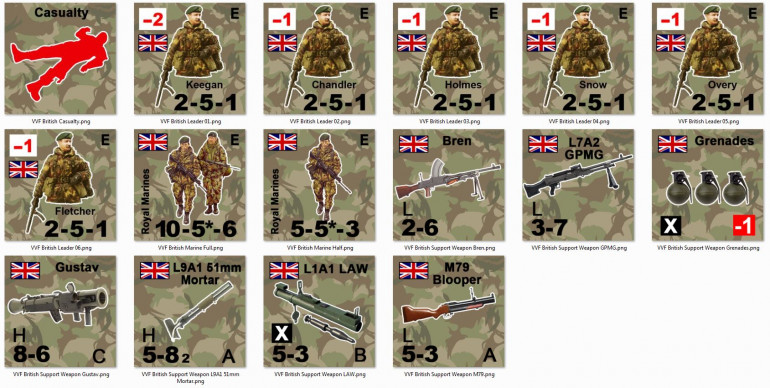 We're underway with a complete Valor & Victory force for Royal Marines in 1982 Falklands. I know I want to build at least another force for Paras, and then of course Argentine infantry that opposed them. Other options might eventually include Scots Guards, Welsh Guards, Gurkhas, depending on community support. I hope to stream a demo game UK vs. Argentinian infantry battles in Valor & Victory of this sometime on Sunday, May 26 - again, depending on community interest. Stay tuned.
We're underway with a complete Valor & Victory force for Royal Marines in 1982 Falklands. I know I want to build at least another force for Paras, and then of course Argentine infantry that opposed them. Other options might eventually include Scots Guards, Welsh Guards, Gurkhas, depending on community support. I hope to stream a demo game UK vs. Argentinian infantry battles in Valor & Victory of this sometime on Sunday, May 26 - again, depending on community interest. Stay tuned. Open Invite: Wargames on the Weekend
Once again it’s time to “stiffen the sinews, summon up the blood, disguise fair nature with hard favor’d rage ” … and take your dice to the wargame table.
As always we’ll be running wargames on the web this weekend!
If anyone wants to play in any of the games listed below, please let me know what game, what day and time, and which faction you’d prefer, as soon as you can so I can start building the scenario.
Options (Saturday at 17:30 UK time or Sunday 17:00 UK time):
- Darkstar (please let me know what faction you’d prefer)
- Valor & Victory (VWW1, WW2, Vietnam, Lebanon, or even Falklands if I can get some counters and maps put together)
- Arab-Israeli Wars (1956, 67, 73, or 82 Lebanon)
- Tactical Combat Middle East (Panzer Leader in 1991)
- Panzer Leader WW2 as always, virtually any theater or campaign. 😀
- AirWar C21 for the Falklands, 1982.
- Naval Command for Falklands, 1982
Again, if interested – either in playing or in spectating, please let me know with a PM.
On Sunday, I would actually like to give Falklands 1982 a swing in Valor & Victory if anyone is interested. This would help facilitate the last Falklands episode for the Ops Center, but of course I’ll run whatever the players are most interested in.
First come first serve, and I need time to build the scenarios.
Hope to see some of you there! Either way, have a great weekend!
JIM
Sitrep Twitch Live Steam, 8PM UK Time
Good afternoon, everyone!
The Sitrep Podcast Channel is hosting another live stream on twitch this afternoon.
Time: 8PM UK Time / 3PM East US Time
Game: AirWar C21 (Wessex Games)
Setting: Falklands War 1982
Scenario: Argentinian bombing attempt on British warships conducting shore bombardment on Port Stanley Airport. Mirage III EAs escorting A-4 Skyhawks on attack run, intercepted by FRS1 Sea Harriers in Combat Air Patrol and air defense systems of HMS Glamorgan and HMS Alacrity.
Check us out on Twitch and see how we do!
We hope to see some of you there!
Naval Command: Falkands Game Report!
This weekend my friend @elessar2590 and I took our first swing at a new game in a new genre: Modern naval combat. Well, virtually a new genre for me, at least, I remember playing Harpoon back in the 1980s and early 1990s but haven’t really looked at modern naval operations in wargaming since then.
But Sunday we tried “Naval Command” – specifically for a scenario in the 1982 Falklands conflict.
Sitrep followers will certainly know that we’ve been running a lot of Falklands content lately, in support of our ongoing Ops Center video series on the topic. I started looking at Naval Command as a system that could quickly and easily give us a look at the overall naval, maritime, and littoral operations involved with the British landings on the Falklands. Harpoon is probably the “gold standard” for this kind of thing, but it’s also a very detail-intense and heavy-investment game from a research, prep, and paperwork perspective.
Accordingly, Sunday’s game was sort of a “live playtest” for the system, available for viewing in its 5-hour entirety on the Sitrep Twitch Channel. But here are the highlights of the battle report.
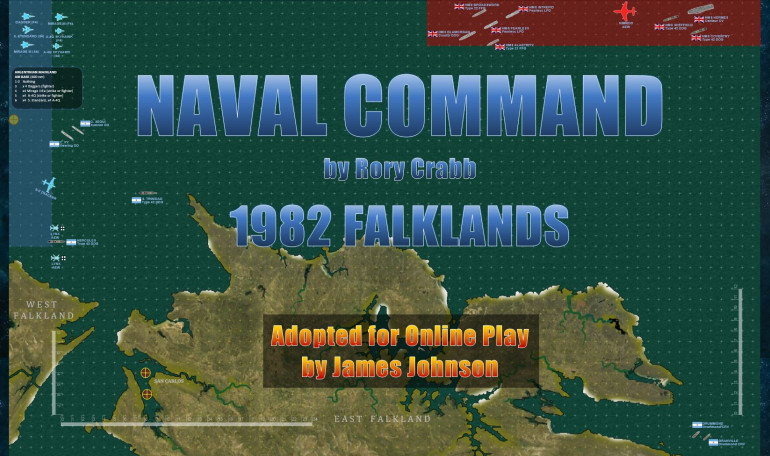 So here was our title slide for the stream. Was the game system good? I … THINK so. We’ve only had one live game so far so I can’t say too much right now. I think the BOOK needs a “come-to-Jesus” moment with a hard-eyed copy editor and data-checker, but the concepts presented, turn sequence, level of detail, and scope of study are great. It’s not too much, not too little. In addition to what we explore in this particular game, Naval Command addresses aspects like submarines, sonar, airborne sonar (dipped, sonobuoys), landing operations, anti-piracy operations, rules of engagement in areas not in declared warzones, etc. So I THINK I can recommend the game, but honestly need a few more tried to be 100% sure. We definitely had some fun (and admittedly, some difficulties) with this one, though.
So here was our title slide for the stream. Was the game system good? I … THINK so. We’ve only had one live game so far so I can’t say too much right now. I think the BOOK needs a “come-to-Jesus” moment with a hard-eyed copy editor and data-checker, but the concepts presented, turn sequence, level of detail, and scope of study are great. It’s not too much, not too little. In addition to what we explore in this particular game, Naval Command addresses aspects like submarines, sonar, airborne sonar (dipped, sonobuoys), landing operations, anti-piracy operations, rules of engagement in areas not in declared warzones, etc. So I THINK I can recommend the game, but honestly need a few more tried to be 100% sure. We definitely had some fun (and admittedly, some difficulties) with this one, though. 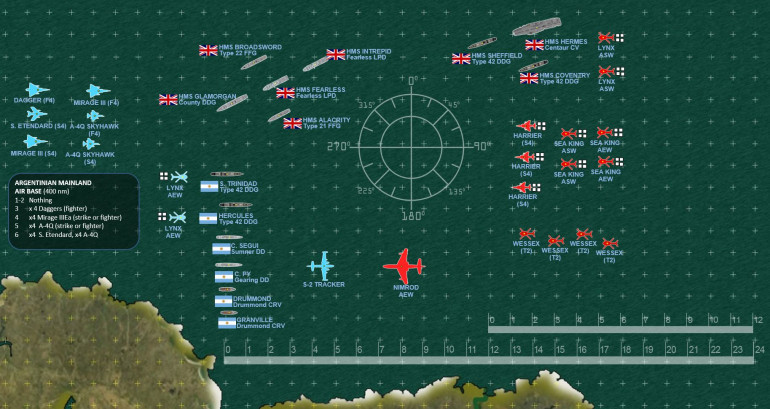 So here are the forces on a partial map. Right off the bat, some viewers are going to see a major curiosity here … why is the Argentinian Navy even on the table? At least their surface fleet was withdrawn to port after the sinking of the light cruiser ARA General Belgrano. Well, again … this is a playtest game, and we wanted to test warships against each other. So we’re trying out a little alternate history here, postulating what initial British landings at San Carlos would have looked like had the Argentinian Navy actually had some surface ships making a stand at the Falklands. The British force is two basic task forces, a landing force (LPDs HMS Fearless and Intrepid) and their escorts, and a carrier support force (CV HMS Hermes and her two Type 42 escorting destroyers). The Argentinians have a small force of destroyers, two Drummond-class corvettes, a squadron of “Pucara” counter-insurgency aircraft at Port Stanley Airport (unable to operate larger craft in the wake of Blackbuck bombing missions and follow up strikes on the airport. MOST IMPORTANTLY for the Argentinians, they have air strikes that SOMETIMES come in from the Argentinian mainland, per d6 rolls on the small mini-table on the left. If any aircraft do arrive, they have no “fuel” tracker, they are assumed to already be at the turn-around point after flying 400 nautical miles from the Argentinian mainland. They get one attack phase on the table and then must leave. Next turn the Argentinians can roll for new aircraft.
So here are the forces on a partial map. Right off the bat, some viewers are going to see a major curiosity here … why is the Argentinian Navy even on the table? At least their surface fleet was withdrawn to port after the sinking of the light cruiser ARA General Belgrano. Well, again … this is a playtest game, and we wanted to test warships against each other. So we’re trying out a little alternate history here, postulating what initial British landings at San Carlos would have looked like had the Argentinian Navy actually had some surface ships making a stand at the Falklands. The British force is two basic task forces, a landing force (LPDs HMS Fearless and Intrepid) and their escorts, and a carrier support force (CV HMS Hermes and her two Type 42 escorting destroyers). The Argentinians have a small force of destroyers, two Drummond-class corvettes, a squadron of “Pucara” counter-insurgency aircraft at Port Stanley Airport (unable to operate larger craft in the wake of Blackbuck bombing missions and follow up strikes on the airport. MOST IMPORTANTLY for the Argentinians, they have air strikes that SOMETIMES come in from the Argentinian mainland, per d6 rolls on the small mini-table on the left. If any aircraft do arrive, they have no “fuel” tracker, they are assumed to already be at the turn-around point after flying 400 nautical miles from the Argentinian mainland. They get one attack phase on the table and then must leave. Next turn the Argentinians can roll for new aircraft. 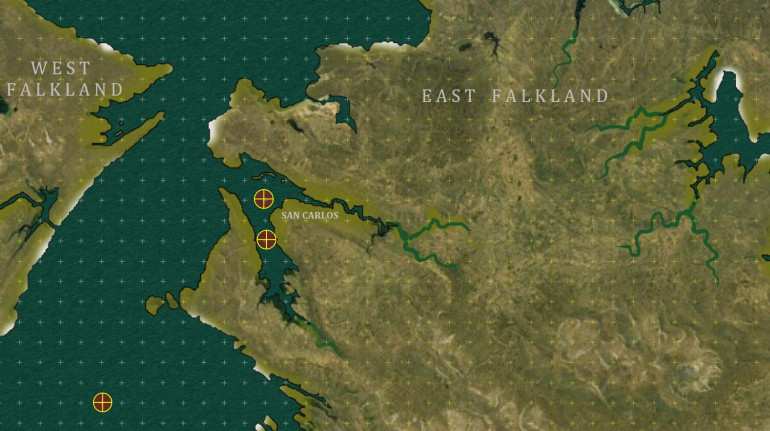 Here are the objectives. Historically the British made two landings at the San Carlos inlet, as we show here. Also, at least one surface warship must end the game at the southern target marker, to reflect the historical mission of probing Falkland Sound to see if it was mined and safe for British naval, littoral, and maritime surface traffic.
Here are the objectives. Historically the British made two landings at the San Carlos inlet, as we show here. Also, at least one surface warship must end the game at the southern target marker, to reflect the historical mission of probing Falkland Sound to see if it was mined and safe for British naval, littoral, and maritime surface traffic.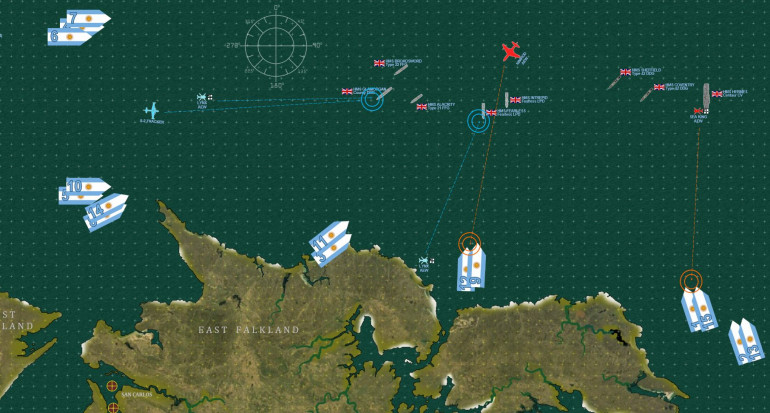 The end of movement on Turn 01. Notice that the Argentinian warships are under “blind” markers numbered 1-15. There are only six Argentinian warships on the table, which means nine of these are false. Elessar2590, as the British player, has to launch Sea King AEW helos and use his Nimrod AEW search aircraft to fix and identify these potential targets, filtering out the false signals and locking down the true targets, then engaging with surface warships or aircraft from HMS Hermes. The Argentinian player (me) must also “detect” British warships or LPDs before they are eligible to be attacked. Detection is EVERYTHING in modern naval warfare, the ranges of modern missiles and the lethality of modern payloads are such that everything hits, everything kills, everything dies … the only real protection you have is electronic warfare and keeping yourself hidden while fixing the enemy first. This means, in a word … HELICOPTERS. Given the scale of modern naval warfare engagement ranges (up to 600NM) and the speed of ships (30+ knots), the only way for a warship to conduct any kind of meaningful search is AEW-equipped helos (AEW = Airborne Early Warning).
The end of movement on Turn 01. Notice that the Argentinian warships are under “blind” markers numbered 1-15. There are only six Argentinian warships on the table, which means nine of these are false. Elessar2590, as the British player, has to launch Sea King AEW helos and use his Nimrod AEW search aircraft to fix and identify these potential targets, filtering out the false signals and locking down the true targets, then engaging with surface warships or aircraft from HMS Hermes. The Argentinian player (me) must also “detect” British warships or LPDs before they are eligible to be attacked. Detection is EVERYTHING in modern naval warfare, the ranges of modern missiles and the lethality of modern payloads are such that everything hits, everything kills, everything dies … the only real protection you have is electronic warfare and keeping yourself hidden while fixing the enemy first. This means, in a word … HELICOPTERS. Given the scale of modern naval warfare engagement ranges (up to 600NM) and the speed of ships (30+ knots), the only way for a warship to conduct any kind of meaningful search is AEW-equipped helos (AEW = Airborne Early Warning). Just to have a bit of fun, those nine “false” Argentinian ship positions, when their signals are detected by Elessar’s AEW / search assets and revealed, have funny little “Easter Eggs” beneath them that show what he has in fact found … instead of any of my Argentinian destroyers or corvettes. :D Here’s hoping for lots of “Sexy Mermaids.”
Just to have a bit of fun, those nine “false” Argentinian ship positions, when their signals are detected by Elessar’s AEW / search assets and revealed, have funny little “Easter Eggs” beneath them that show what he has in fact found … instead of any of my Argentinian destroyers or corvettes. :D Here’s hoping for lots of “Sexy Mermaids.”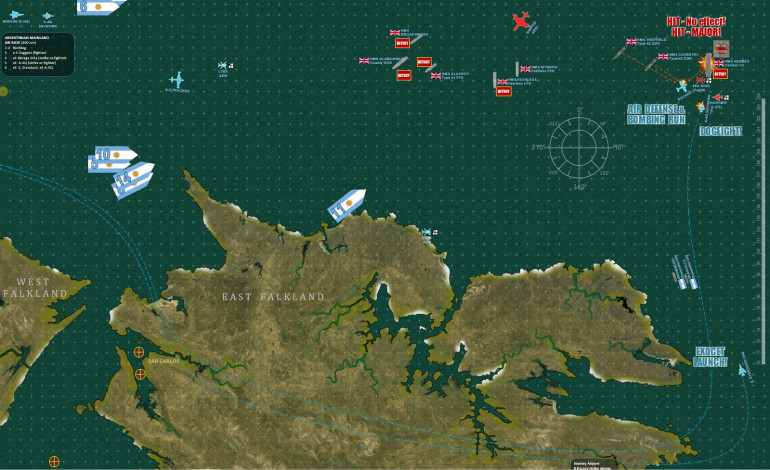 So this game loses NO time in getting started. After our initiative, detection, and navigation phases, the Argentinian attack phase begins with a “6” on that aircraft arrival chart. Rolled on camera, and yes, it’s the best possible roll. I’ll never get an opportunity like this again, so I go for broke. The four “Super Entendard” naval strike craft and four A-4Q “Skyhawk” carrier fighter-bombers streak in, dip way south over East Falkland Island, and turn north over the Port Stanley Airport at lower right. This circuitous route is to stay more than 24” away from the three Sea Harriers Elessar launched from the deck of HMS Hermes (CAP interception range). I also launch four Pucara COIN aircraft from Port Stanley and put all twelve aircraft on a do-or-die strike on HMS Hermes. Again, I’ll never get another chance like this, not only does Elessar not really have a lot of Harriers launched yet, but almost no one has their active sensors switched on (a conscious choice to remain hidden as long as possible). While this would normally help Hermes stay hidden, it h ow hampers her air defense systems. GOOD NEWS FIRST – the four Super Entendards launch their four AS-39 “Exocent” antiship missiles. Note they launch from more than 24” inches away from the Harriers (Exocets have an 80” range). One fails to lock on and splashes. Two are shot down, one by HMS Hermes and one by HMS Sheffield. The fourth one hits, but I only roll a “2” on 1d10+3 damage, resulting in 5 total, not enough to cause significant damage to HMS Hermes. She can still make full steam, has full weapons and sensors, and more importantly, operate a full flight deck.
So this game loses NO time in getting started. After our initiative, detection, and navigation phases, the Argentinian attack phase begins with a “6” on that aircraft arrival chart. Rolled on camera, and yes, it’s the best possible roll. I’ll never get an opportunity like this again, so I go for broke. The four “Super Entendard” naval strike craft and four A-4Q “Skyhawk” carrier fighter-bombers streak in, dip way south over East Falkland Island, and turn north over the Port Stanley Airport at lower right. This circuitous route is to stay more than 24” away from the three Sea Harriers Elessar launched from the deck of HMS Hermes (CAP interception range). I also launch four Pucara COIN aircraft from Port Stanley and put all twelve aircraft on a do-or-die strike on HMS Hermes. Again, I’ll never get another chance like this, not only does Elessar not really have a lot of Harriers launched yet, but almost no one has their active sensors switched on (a conscious choice to remain hidden as long as possible). While this would normally help Hermes stay hidden, it h ow hampers her air defense systems. GOOD NEWS FIRST – the four Super Entendards launch their four AS-39 “Exocent” antiship missiles. Note they launch from more than 24” inches away from the Harriers (Exocets have an 80” range). One fails to lock on and splashes. Two are shot down, one by HMS Hermes and one by HMS Sheffield. The fourth one hits, but I only roll a “2” on 1d10+3 damage, resulting in 5 total, not enough to cause significant damage to HMS Hermes. She can still make full steam, has full weapons and sensors, and more importantly, operate a full flight deck.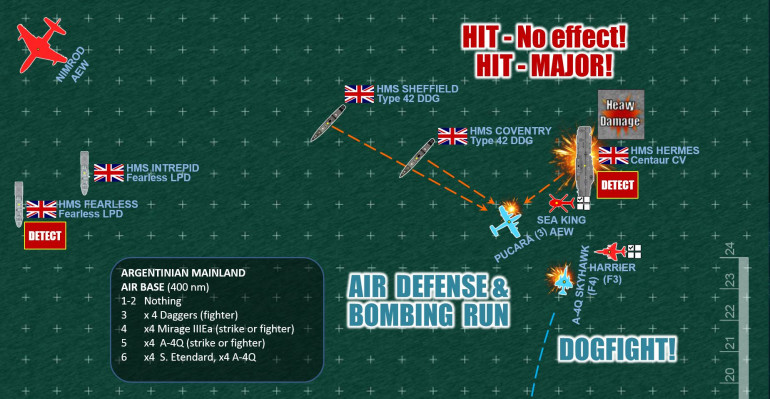 Zooming in, however, we can see where the Hermes’ luck runs out later that same attack phase. The escorting Skyhawks go in for a bombing run. They are intercepted by the Harriers (the Skyhawks can’t avoid this, bombing range is 0”). The Harriers win the dogfight, fending off the Skyhawks and shooting one of them down. But this means that there’s no one to stop the Pucara counterinsurgency aircraft. The Hermes, Sheffield, and Coventry all get an air defense roll, which is now -1 because this is their second air defense roll (first was shooting down those Exocets). One Pucara is shot down but three more get through, and all three hit with bombs. Two bombs don’t do enough damage to register (each ship has a “light damage” and a “heavy damage” threshold) – but the third bomb rolls a 10, +4 = 14, easily enough to cause a HEAVY DAMAGE counter on the Hermes. BOOM. Hermes isn’t sunk, but she’s definitely got major issues including half speed, and NO FLIGHT DECK. She can’t even recover the Harriers and Sea Knight helos she’s already launched.
Zooming in, however, we can see where the Hermes’ luck runs out later that same attack phase. The escorting Skyhawks go in for a bombing run. They are intercepted by the Harriers (the Skyhawks can’t avoid this, bombing range is 0”). The Harriers win the dogfight, fending off the Skyhawks and shooting one of them down. But this means that there’s no one to stop the Pucara counterinsurgency aircraft. The Hermes, Sheffield, and Coventry all get an air defense roll, which is now -1 because this is their second air defense roll (first was shooting down those Exocets). One Pucara is shot down but three more get through, and all three hit with bombs. Two bombs don’t do enough damage to register (each ship has a “light damage” and a “heavy damage” threshold) – but the third bomb rolls a 10, +4 = 14, easily enough to cause a HEAVY DAMAGE counter on the Hermes. BOOM. Hermes isn’t sunk, but she’s definitely got major issues including half speed, and NO FLIGHT DECK. She can’t even recover the Harriers and Sea Knight helos she’s already launched. 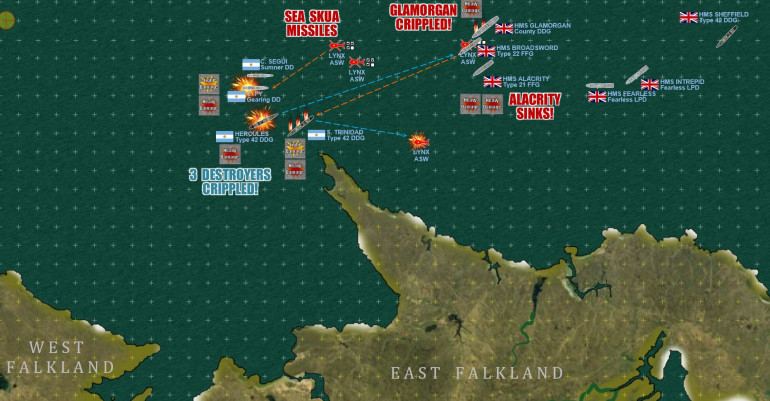 By the end of Turn 3, another major battle has erupted near the opening of Falkland Sound (generally speaking, the channel of water between East and West Falkland Islands). Here, Argentinian destroyers (one Allen M. Sumner Class, one Gearing Class, two Type 42 Class) actually engage in SURFACE combat against destroyer HMS Glamorgan, and frigates HMS Broadsword and Alacrity. I honestly wasn’t expecting this, but oddly both sides are more or less devoid of aircraft right now. The Argentinians rolls a 1 and a 2 on the next two aircraft arrival checks. The Hermes is burning, and the Harriers that are airborne are protecting her and were launched with an interception mission package anyway. The first Pucara element (3 survivors) have landed at Port Stanley on Turn 2. Turn 3 sees the other four Pucaras launched (Port Stanley can only launch / recover four aircraft a turn) but the Harriers and HMS Coventry make short work of them. This means that here, we have, almost unbelievably, a SURFACE GUNNERY duel in 1982 between British and Argentinian destroyers and frigates (4.5” guns, 5” guns, and guided torpedoes). The one exception are the Lynx helos launched from Alacrity, Broadsword, Glamorgan, and the approaching Sheffield, carrying “Sea Skua” short range missiles. The Argentinian destroyer Hercules is something of a hero ship here, shooting down one of the helos, other missiles, and outright SINKING frigate HMS Alacrity. But the British are of course responding, especially HMS Broadsword, and they quickly cripple many of the Argentinian warships. Note that once a ship has a single “Heavy Hit” counter on it, it can no longer use any primary weapons. So Elessar’s objective here is to put at least one Heavy Hit on all my destroyers, while maintaining at least one of his ships without one. That’s going to be the winner here, and what determines whether HMS Fearless and Intrepid get into Falkland Sound and San Carlos Water.
By the end of Turn 3, another major battle has erupted near the opening of Falkland Sound (generally speaking, the channel of water between East and West Falkland Islands). Here, Argentinian destroyers (one Allen M. Sumner Class, one Gearing Class, two Type 42 Class) actually engage in SURFACE combat against destroyer HMS Glamorgan, and frigates HMS Broadsword and Alacrity. I honestly wasn’t expecting this, but oddly both sides are more or less devoid of aircraft right now. The Argentinians rolls a 1 and a 2 on the next two aircraft arrival checks. The Hermes is burning, and the Harriers that are airborne are protecting her and were launched with an interception mission package anyway. The first Pucara element (3 survivors) have landed at Port Stanley on Turn 2. Turn 3 sees the other four Pucaras launched (Port Stanley can only launch / recover four aircraft a turn) but the Harriers and HMS Coventry make short work of them. This means that here, we have, almost unbelievably, a SURFACE GUNNERY duel in 1982 between British and Argentinian destroyers and frigates (4.5” guns, 5” guns, and guided torpedoes). The one exception are the Lynx helos launched from Alacrity, Broadsword, Glamorgan, and the approaching Sheffield, carrying “Sea Skua” short range missiles. The Argentinian destroyer Hercules is something of a hero ship here, shooting down one of the helos, other missiles, and outright SINKING frigate HMS Alacrity. But the British are of course responding, especially HMS Broadsword, and they quickly cripple many of the Argentinian warships. Note that once a ship has a single “Heavy Hit” counter on it, it can no longer use any primary weapons. So Elessar’s objective here is to put at least one Heavy Hit on all my destroyers, while maintaining at least one of his ships without one. That’s going to be the winner here, and what determines whether HMS Fearless and Intrepid get into Falkland Sound and San Carlos Water.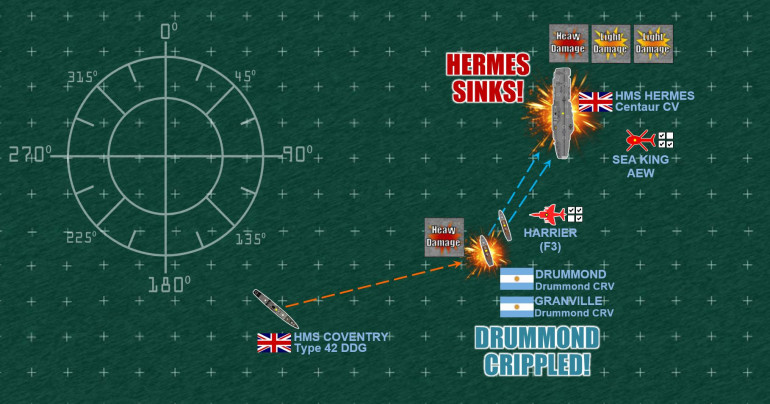 Pretty sure that I will lose that destroyer battle to the west, I send in my two corvettes on a mad attempt to win a moral victory by putting just one more “Heavy Hit” (or two “Light Hits”) on the damaged HMS Hermes. It’s probably going to cost me both ships in the end, but I do get two more Light Hits, and Hermes fails both damage control checks (you can make damage control checks on light damage but not heavy damage). Hermes is an irrecoverable wreck and will probably be scuttled in the coming hours or days, if she’s not sinking already. One more flight of four Mirages arrives on Turn 4, I decide on two fighters and two strike loads. The two strike loads are shot down long before they reach the HMS Fearless, and the fighters don’t want to tangle with three Harriers (even if the Harriers will have to pull out this turn due to fuel to make it back to emergency landings on HMS Invincible somewhere).
Pretty sure that I will lose that destroyer battle to the west, I send in my two corvettes on a mad attempt to win a moral victory by putting just one more “Heavy Hit” (or two “Light Hits”) on the damaged HMS Hermes. It’s probably going to cost me both ships in the end, but I do get two more Light Hits, and Hermes fails both damage control checks (you can make damage control checks on light damage but not heavy damage). Hermes is an irrecoverable wreck and will probably be scuttled in the coming hours or days, if she’s not sinking already. One more flight of four Mirages arrives on Turn 4, I decide on two fighters and two strike loads. The two strike loads are shot down long before they reach the HMS Fearless, and the fighters don’t want to tangle with three Harriers (even if the Harriers will have to pull out this turn due to fuel to make it back to emergency landings on HMS Invincible somewhere). 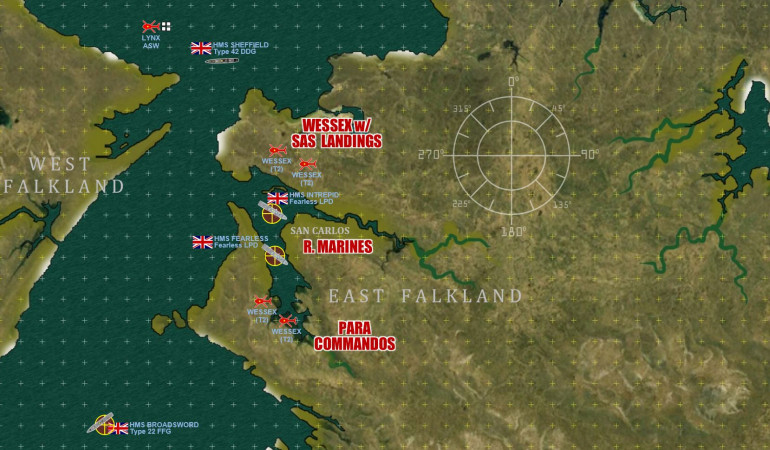 Sure enough, HMS Broadsword puts more damage into the old American WW2 Sumner-class destroyer ARA Comodoro Segui (my last destroyer) and finally leaves her crippled without guns. While no Argentinian ships actually sink (at least not yet), all four destroyers are now bereft of main armament and basically helpless before HMS Broadsword and even worse, HMS Sheffield right behind. This leaves the channel open for HMS Fearless and Intrepid to raise steam for flank speed into the channel, launching Wessex transport birds to carry SAS teams to the high ground overlooking the landing zones. The objective hexes are all reached, with HMS Broadsword confirming that Falkland Sound is NOT mined and HMS Sheffield north mouth of the south in case the Argentinians send in more warships or (more likely) aircraft. This was Sheffield’s role more or less historically, and air defense picket ship engaging Argentinian aircraft and missiles from a standoff range from more vulnerable assets of the task force.
Sure enough, HMS Broadsword puts more damage into the old American WW2 Sumner-class destroyer ARA Comodoro Segui (my last destroyer) and finally leaves her crippled without guns. While no Argentinian ships actually sink (at least not yet), all four destroyers are now bereft of main armament and basically helpless before HMS Broadsword and even worse, HMS Sheffield right behind. This leaves the channel open for HMS Fearless and Intrepid to raise steam for flank speed into the channel, launching Wessex transport birds to carry SAS teams to the high ground overlooking the landing zones. The objective hexes are all reached, with HMS Broadsword confirming that Falkland Sound is NOT mined and HMS Sheffield north mouth of the south in case the Argentinians send in more warships or (more likely) aircraft. This was Sheffield’s role more or less historically, and air defense picket ship engaging Argentinian aircraft and missiles from a standoff range from more vulnerable assets of the task force. So how did the game play out overall? The game was definitely an Argentinian win, but with some serious apologies and caveats. The Argentinians won because the British managed to make all the historical objectives (landing HMS Intrepid and Fearless at San Carlos, complete with Wessex transport birds dropping SAS on the high ground overlooking the landing zones for Royal Marines and Paras). British losses in San Carlos were a basically a frigate, which almost matches historically (in our game the British lost HMS Alacrity, historically it was her sistership HMS Ardent). The big difference was the loss of HMS Hermes, which obviously did NOT happen historically.
So here are the apologies and caveats.
One, this was totally an “alternate history” game where the Argentinian Navy mounted any kind of a stand at the Falklands. Historically, their surface fleet was withdrawn to port after the loss of ARA General Belgrano (2 May 1982). Just in putting ships like Santissima Trinidad and Hercules on the table, or really any Argentinian warships at all, is a massive break from the historical situation and a big “upgrade” to the Argentinian Navy’s performance in the war.
Two, HMS Hermes never really should have been this close to the combat zone. Carriers by definition stay hundreds of miles away from the enemy, launching aircraft. Harriers in this system have a 300” combat radius, meaning that HMS Hermes really should have been 200” further northeast, clearly off the table.
Three, even if HMS Hermes decided for whatever mad reason to come anywhere near this close to the actual Falklands, she would have had some aircraft already up, in a CAP role if nothing else. I should have stipulated that @elessar2590 could have started with some aircraft already airborne. This way, even if Hermes’ flight deck was devastated on Turn 1 as we’ve seen above, we would still have more Harriers available (at least as long as fuel allowed) to wreak devastating response on the Argentinian fleet. Although let’s be clear, with 8-10 Harriers up instead of 3, there’s just no way those Super Etendards or Pucaras land those hits.
Four, the Argentinians just got damned lucky. On camera I rolled that first “6” for the Argentinian aircraft arriving from the mainland, and then rolled 7s, 8, and 9s for damage (except that first Exocet). We mixed up the rules a couple of times and so ran the resolution several times until we got it right, the Hermes would up with two “Heavy Damage” counters every time. The old girl just could not catch a break.
So thanks very much to @elessar2590 for being a great sport, and helping out in our “guinea pig” experiment. 😀
LIVE STREAM AT 8PM EASTERN US – BUILDING ARMIES IN PHOTOSHOP
Visit our Sitrep Twitch Channel to check out our live streams, or catch up on hobby, battle reports, painting, and other great content!
UPDATE TO POST:
These are the two counters we created in the live stream. Many more to come! I still need to do:
- British Para Commandos (full and half squads)
- Leaders for Marines, Paras, (12 counters in all)
- British Support Weapons
- Argentinian Conscripts (full and half squads)
- Argentinian Officers (6 counters)
- Argentinian Support Weapons
- About 32-36 counters in all.
Falklands Live Game - 9PM UK time, 4PM US Eastern Time
Okay, the stage is set for our first play-test of Naval Command by Rory Crabb. I’ll be playing live against @elessar2590 tonight at 4PM US Eastern Time, 9PM UK time. If all goes well, the game will be streamed live on the Sitrep Podcast Twitch channel as well, so swing by and check us out! See if the British can repeat their success, or if the Argentinians will repel (or at least critically damage) the initial British landings on the Falklands!
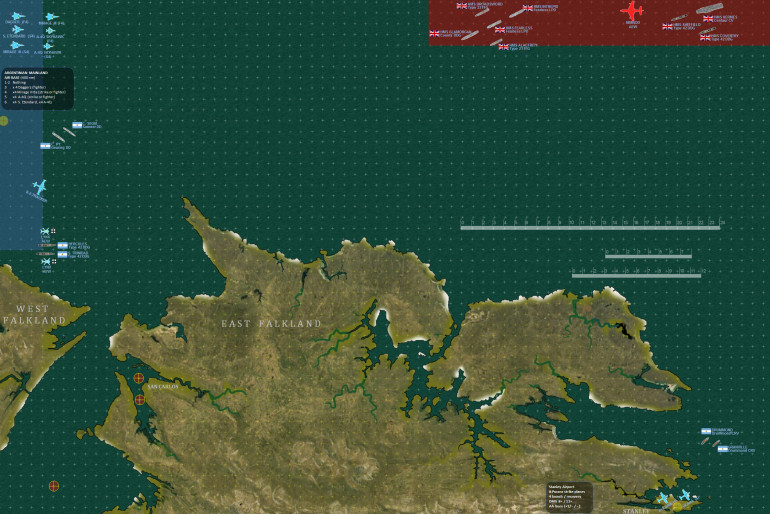 Our 6' x 4' (72 x 48 nautical miles) table for NAVAL COMMAND system. The British are trying to get the LPD assault ships HMS Fearless and HMS Intrepid into the San Carlos Channel off of Falkland Sound, where the initial historical landings took place. Argentinians have Pucara strike aircraft based on the damaged Port Stanley airport, lots more aircraft on their distant mainland bases almost 400 nm to the west. We're also giving the Argentinians a little buff here, putting a few ships in these waters when historically they had been withdrawn to port after the sinking of ARA Belgrano (2 May, 1982).
Our 6' x 4' (72 x 48 nautical miles) table for NAVAL COMMAND system. The British are trying to get the LPD assault ships HMS Fearless and HMS Intrepid into the San Carlos Channel off of Falkland Sound, where the initial historical landings took place. Argentinians have Pucara strike aircraft based on the damaged Port Stanley airport, lots more aircraft on their distant mainland bases almost 400 nm to the west. We're also giving the Argentinians a little buff here, putting a few ships in these waters when historically they had been withdrawn to port after the sinking of ARA Belgrano (2 May, 1982).




























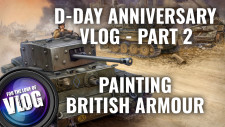


![Watch Out For Firelock Games’ Port Royal Coming Soon! [Updated]](https://images.beastsofwar.com/2024/05/port-royal-main-ks-launch-225-127.jpg)
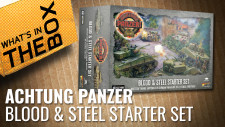


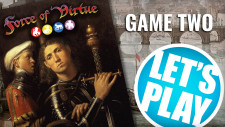
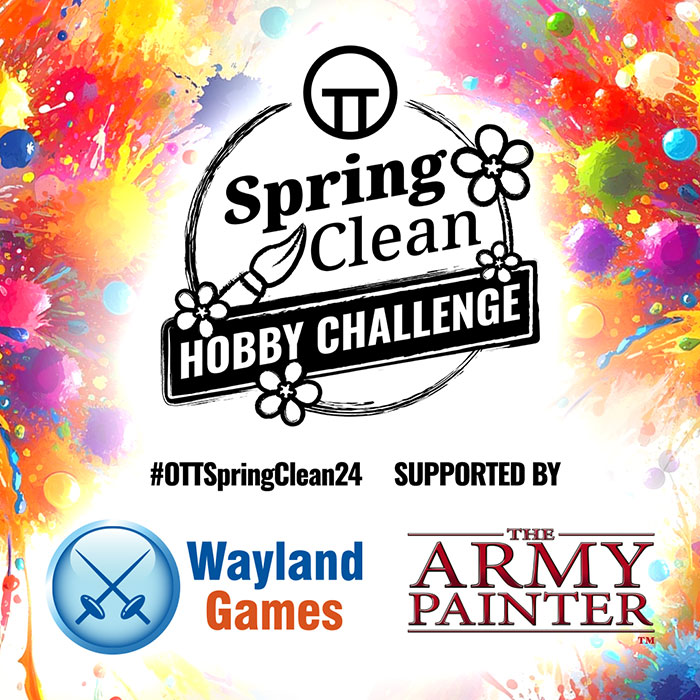



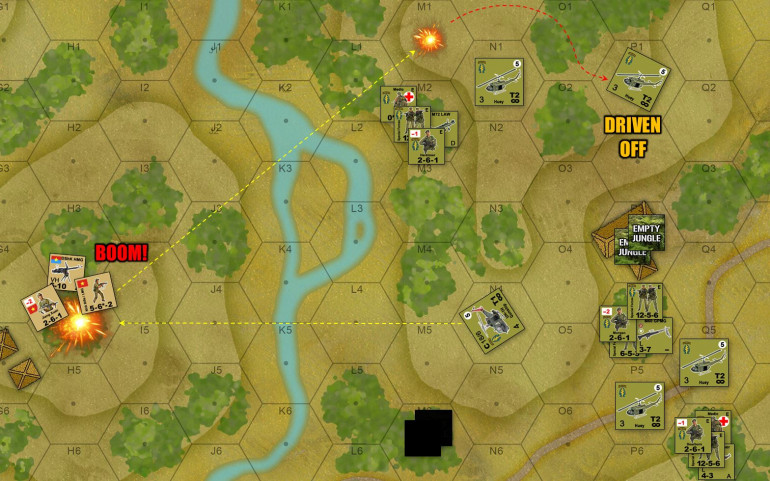
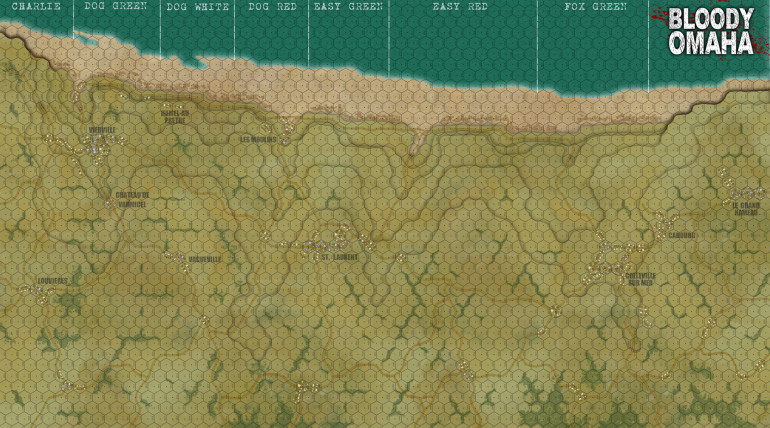
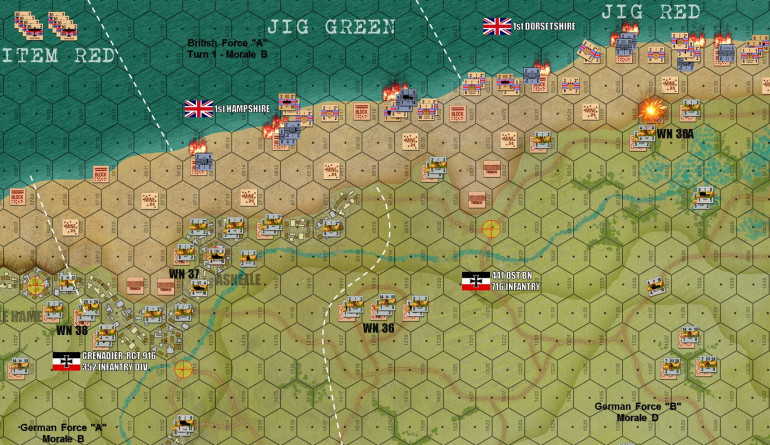
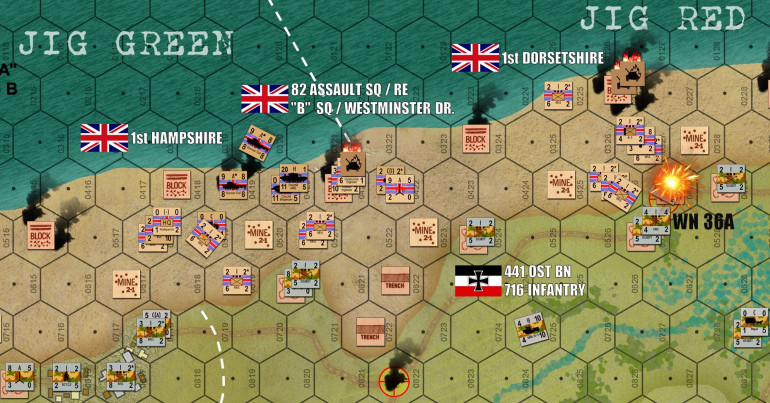
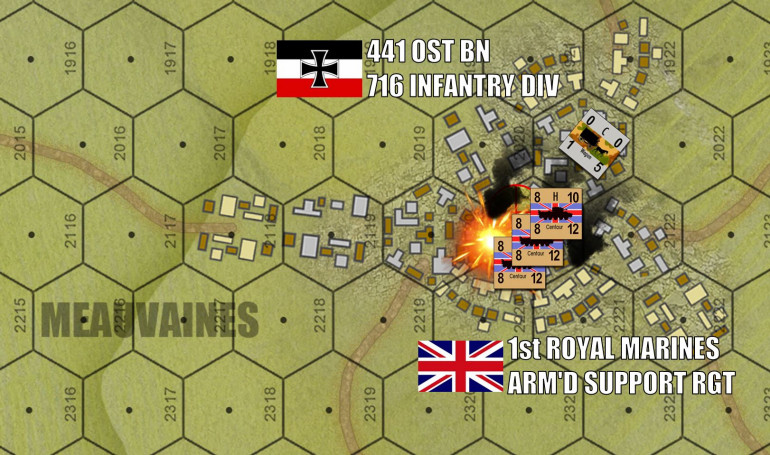
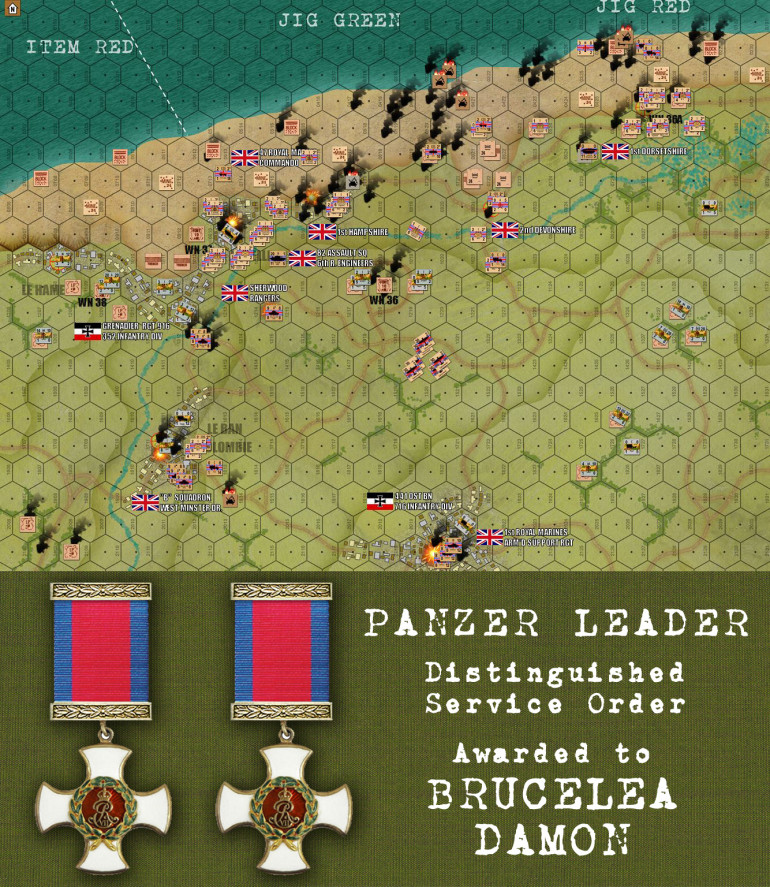
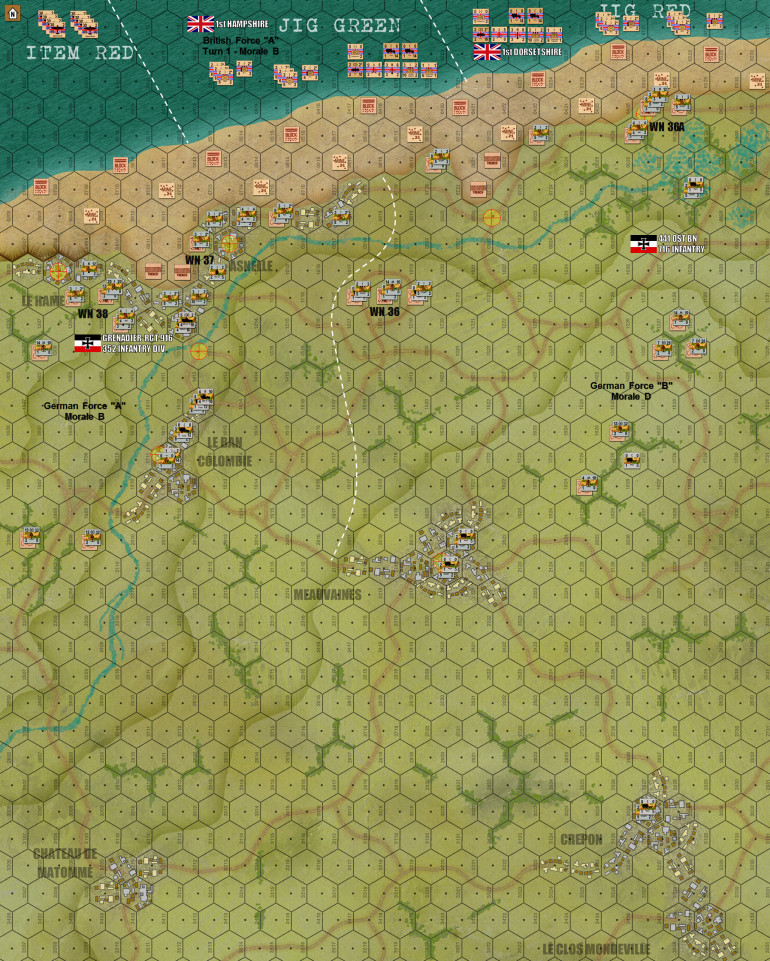

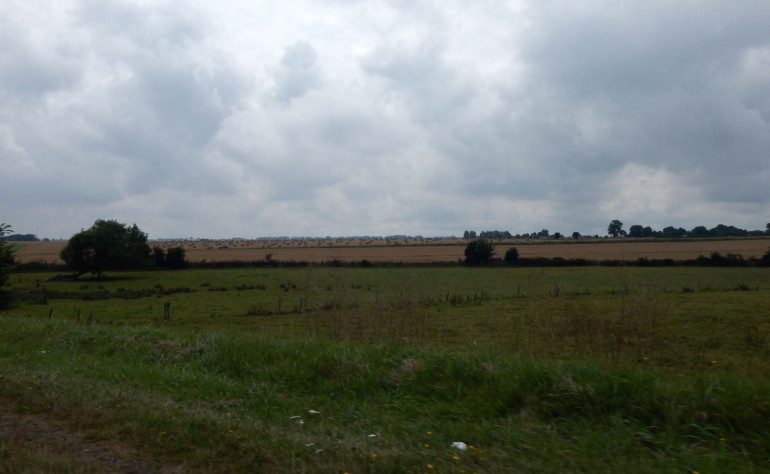
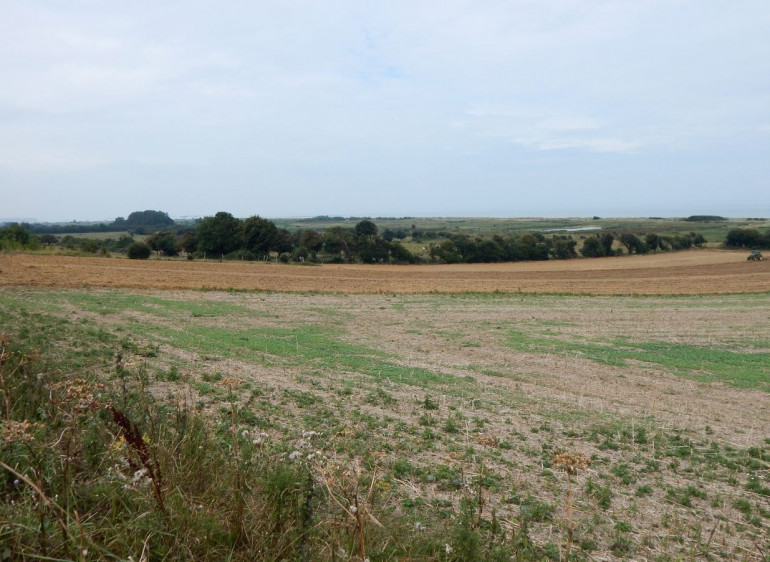
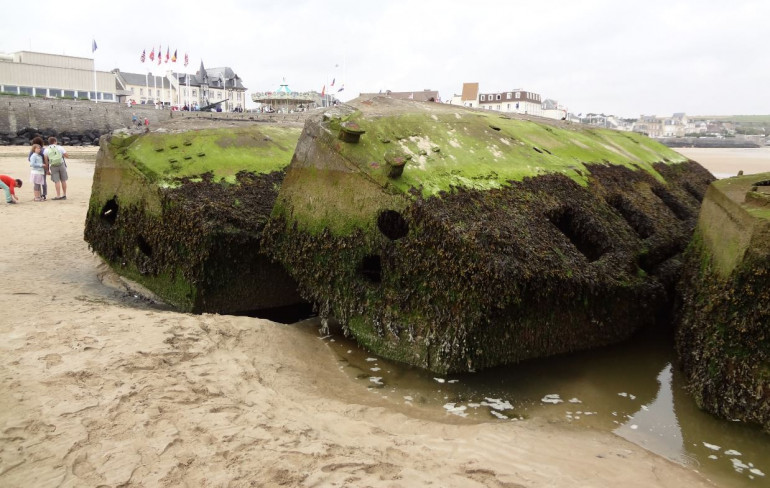
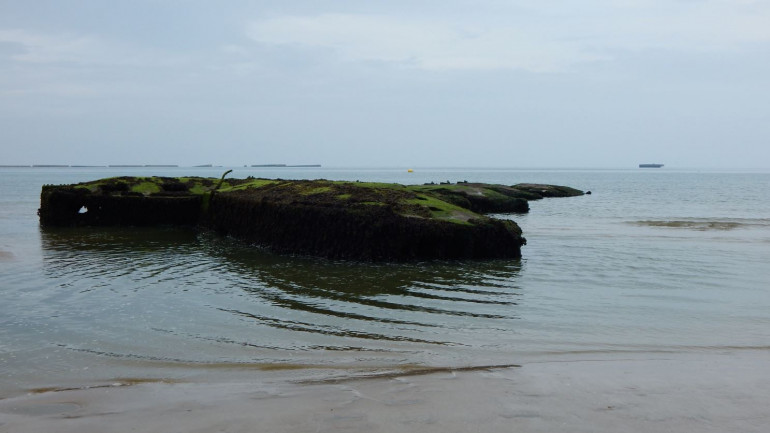
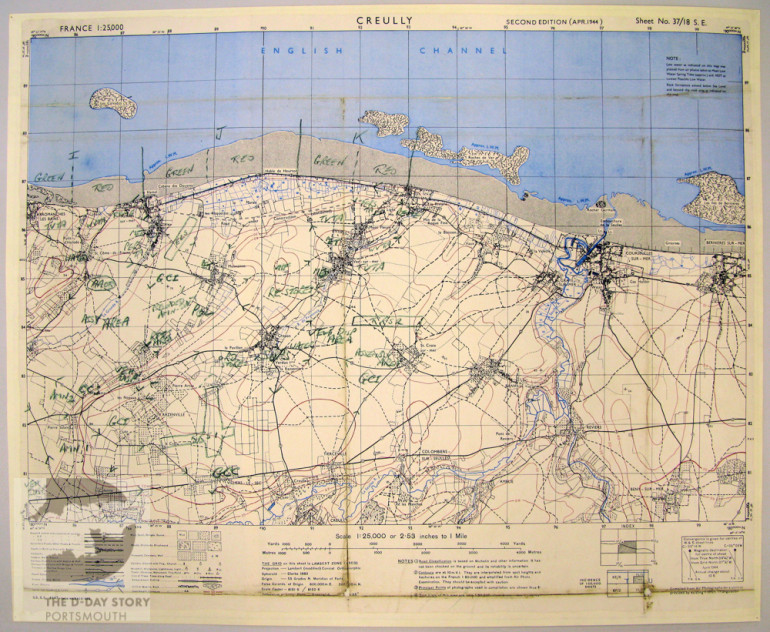
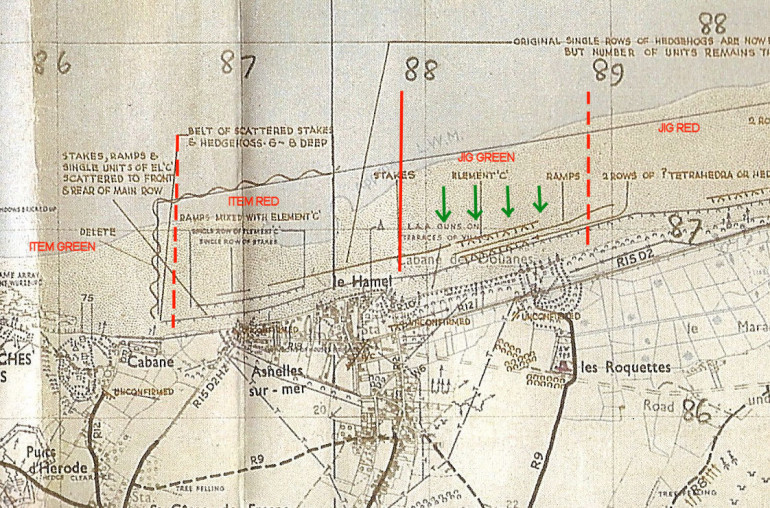
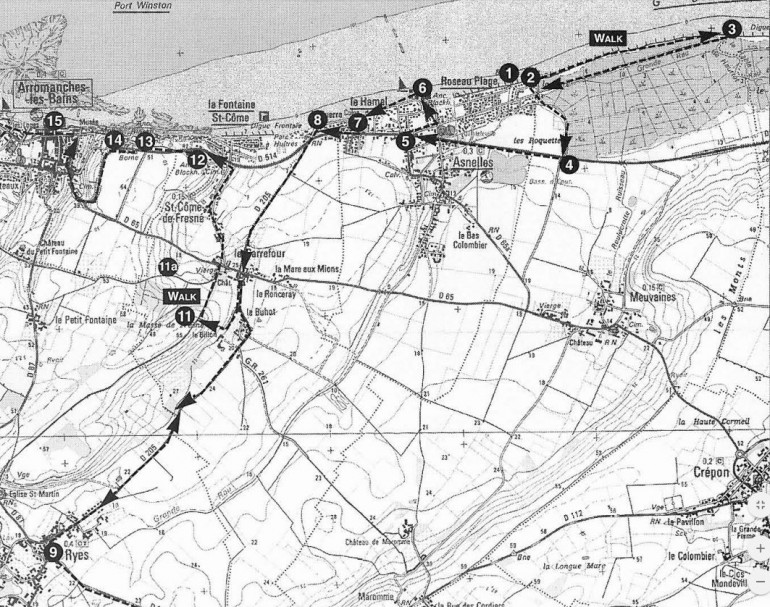
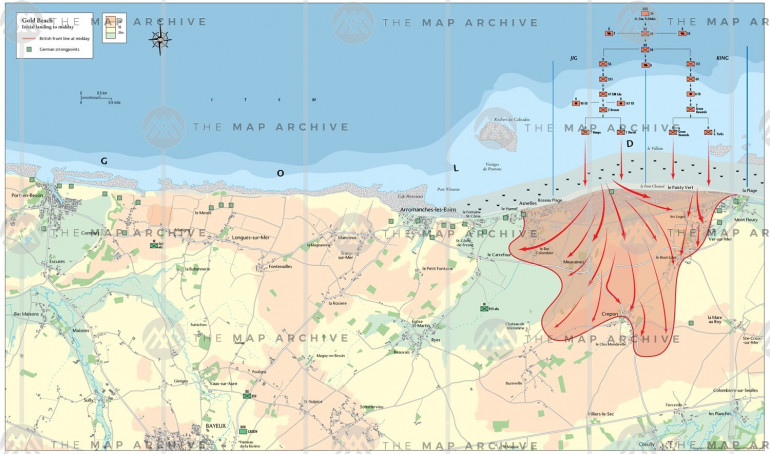
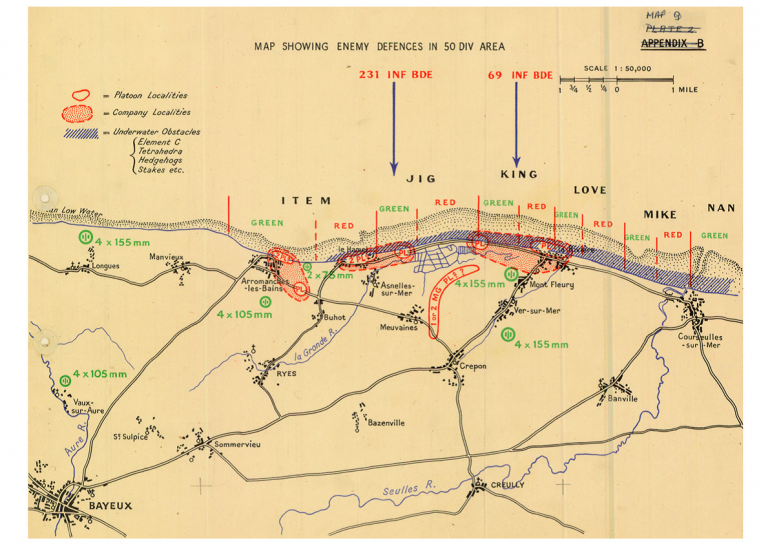
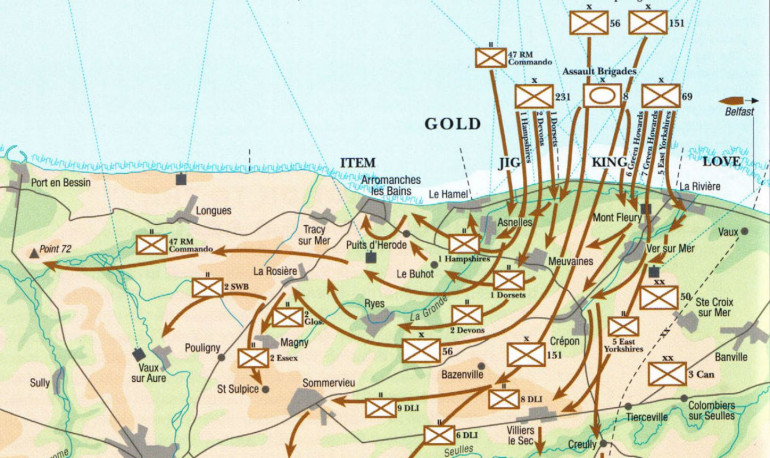
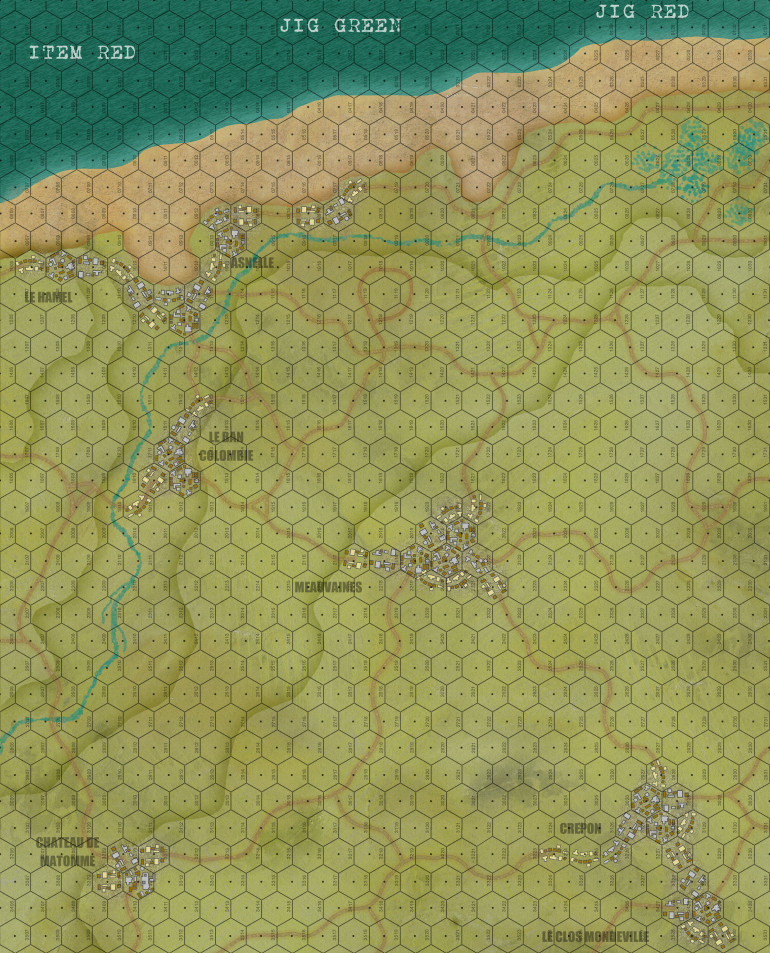
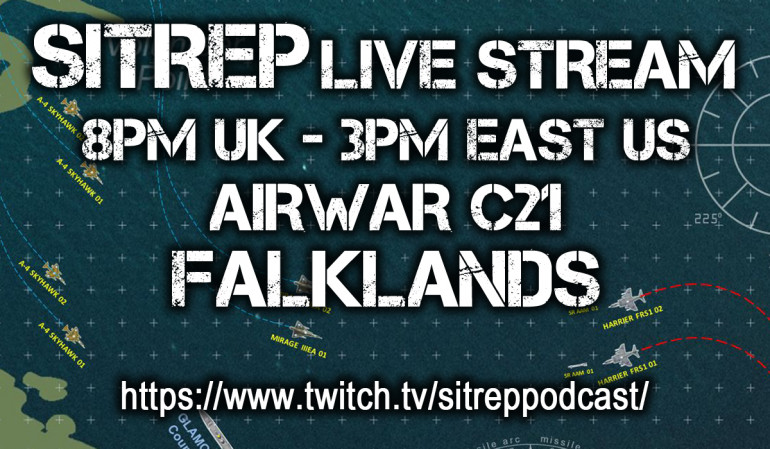
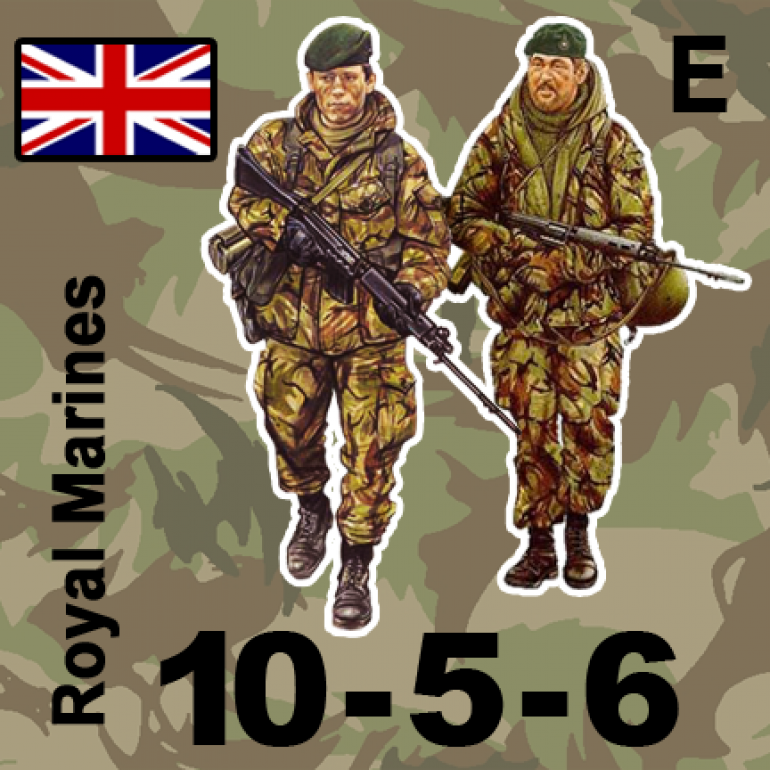
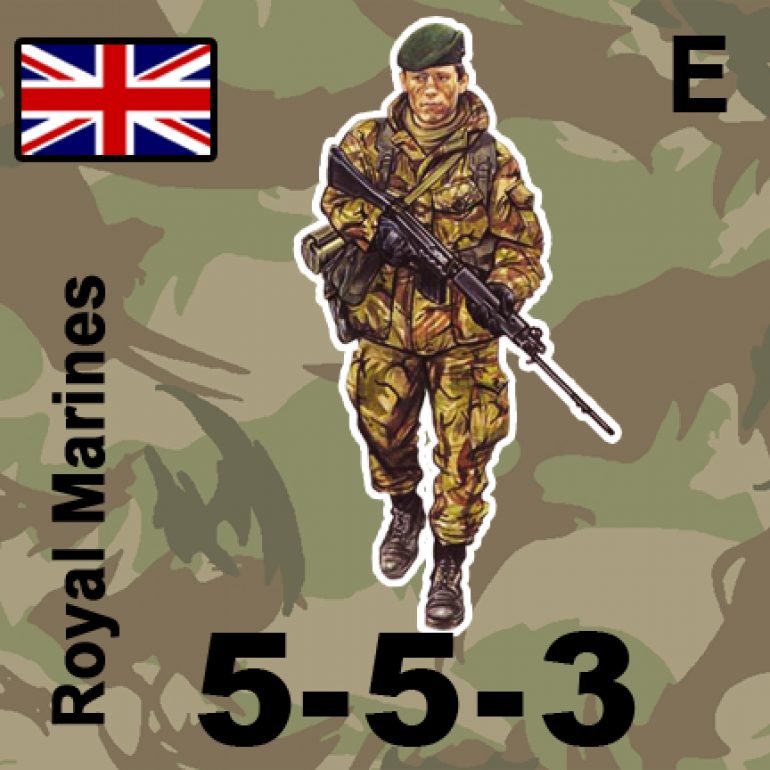

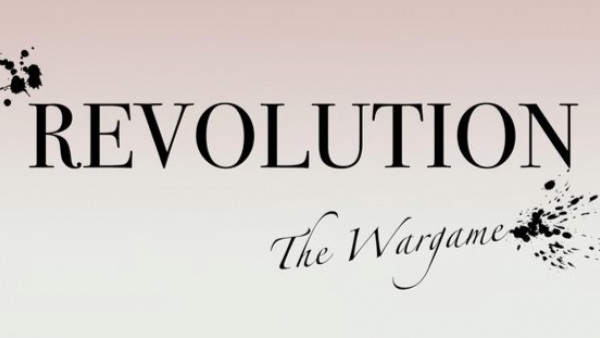

![Watch Out For Firelock Games’ Port Royal Coming Soon! [Updated]](https://images.beastsofwar.com/2024/05/port-royal-main-ks-launch-600-338.jpg)
